
CLICK for LINKS
PTOFBMPPN
The Periodic Table Of Fractal-Based Mersenne Prime - Perfect Numbers (PTOFBMPPN) is in one very real sense, the culmination -- even the summary -- of all that this research has discovered thus far. It comes in the form of a table. That table has two major iterations: the first is the original, base form that gives the "next" Mersenne Primes filled out as xz+y=Mpnext=znext; the second is where the "y" value has been subtracted, giving the Perfect Numbers (PN=xz, and as y=x-1) instead.
The PTOFBNPPN table, while fully laying out the fractal-base distribution of both the "containers" and the embedded MP-PNs, doesn't just sit there in isolation. No way. It is itself completely embedded within the BIM! We just hinted at it in the previous Book IV on the 10-parameters, but now we will be undressing the whole to reveal the parts -- the details. To do so, first will be a review of Book IV material that directly informs much of what will be revealed. Then we will dive into the table itself. Again, any summary of the entire Mp-PN intimacy is going to have its challenges. Going back to the BIM certainly helps in seeing what the table is all about, while studying the table gives real significance to the BIM's presentation of the MPS.
~~~ ~~~ ~~~ ~~~ ~~~ ~~~ ~~~ ~~~ ~~~ ~~~ ~~~ ~~~ ~~~ ~~~ ~~~ ~~~ ~~~ ~~~ ~~~ ~~~ ~~~ ~~~ ~~~ ~~~ ~~~ ~~~ ~~~ ~~~ ~~~ ~~~ ~~~ ~~~
Previously in Book IV:
The 10-Parameters section is an exciting finding! It means there are 10(+) common parameters on every "Diamond-shaped MPS that ALL the individual MPS follow.
It was not exactly a linear, straight-line discovery -- more of some visualizations on the BIM combined with some simple doodling while checking the numerous tables that related different parameters between various MPS and their containers.
We are going to present just a little of that early discovery before quickly diving right in to the 10(+) parameters.
We will be going from simple to advanced.
Like we often do, sometimes the exact same information will be presented in different forms.
A picture is worth a thousand words:
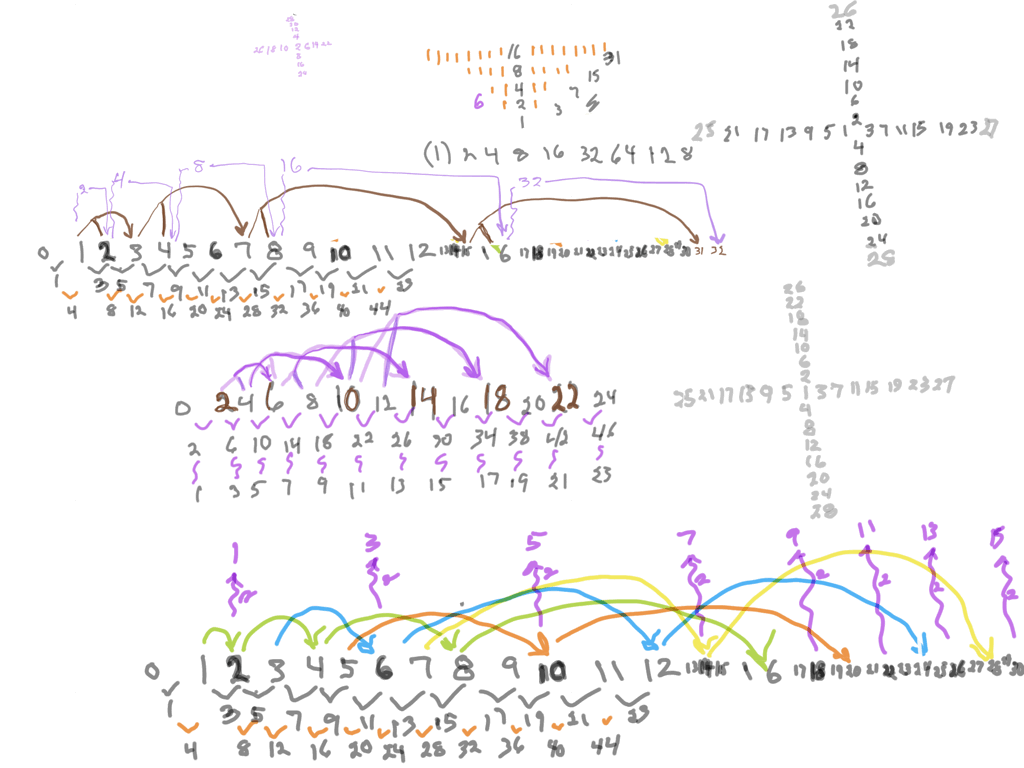
1-2-3-simple.gif
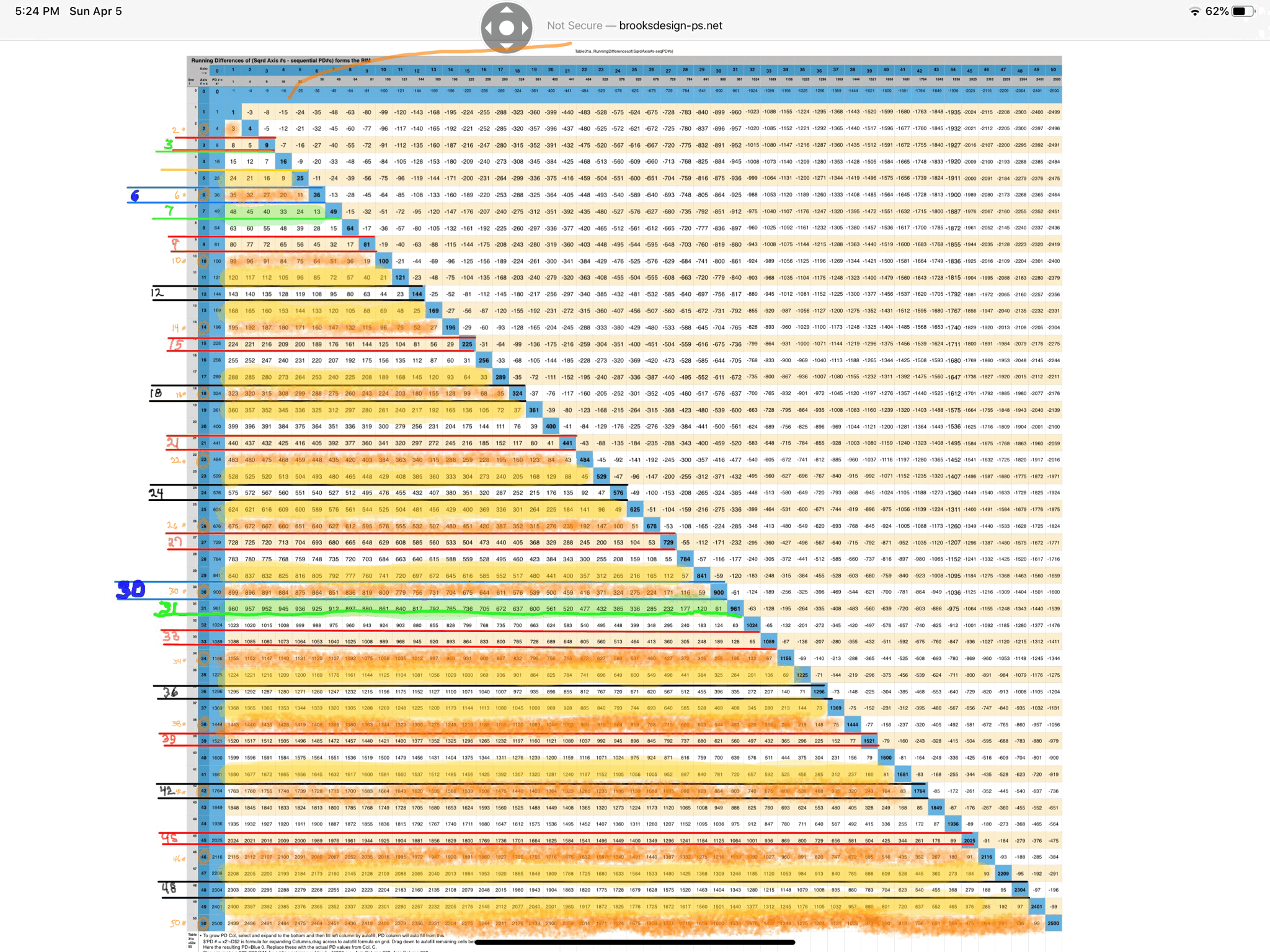
BIM50_AR-NAR-4-6.gif. BIM. BLACK=÷6; GREEN=z=Mersenne Prime; YELLOW=Active Row; RED=Non-Active Row=÷3; ORANGE=EVENS not÷4. ALL Pythagorean Triples and ALL PRIMES are found -- and only found -- on Active YELLOW Rows. Mersenne Primes appear to be found only on the larger of any YELLOW Active Row pair.
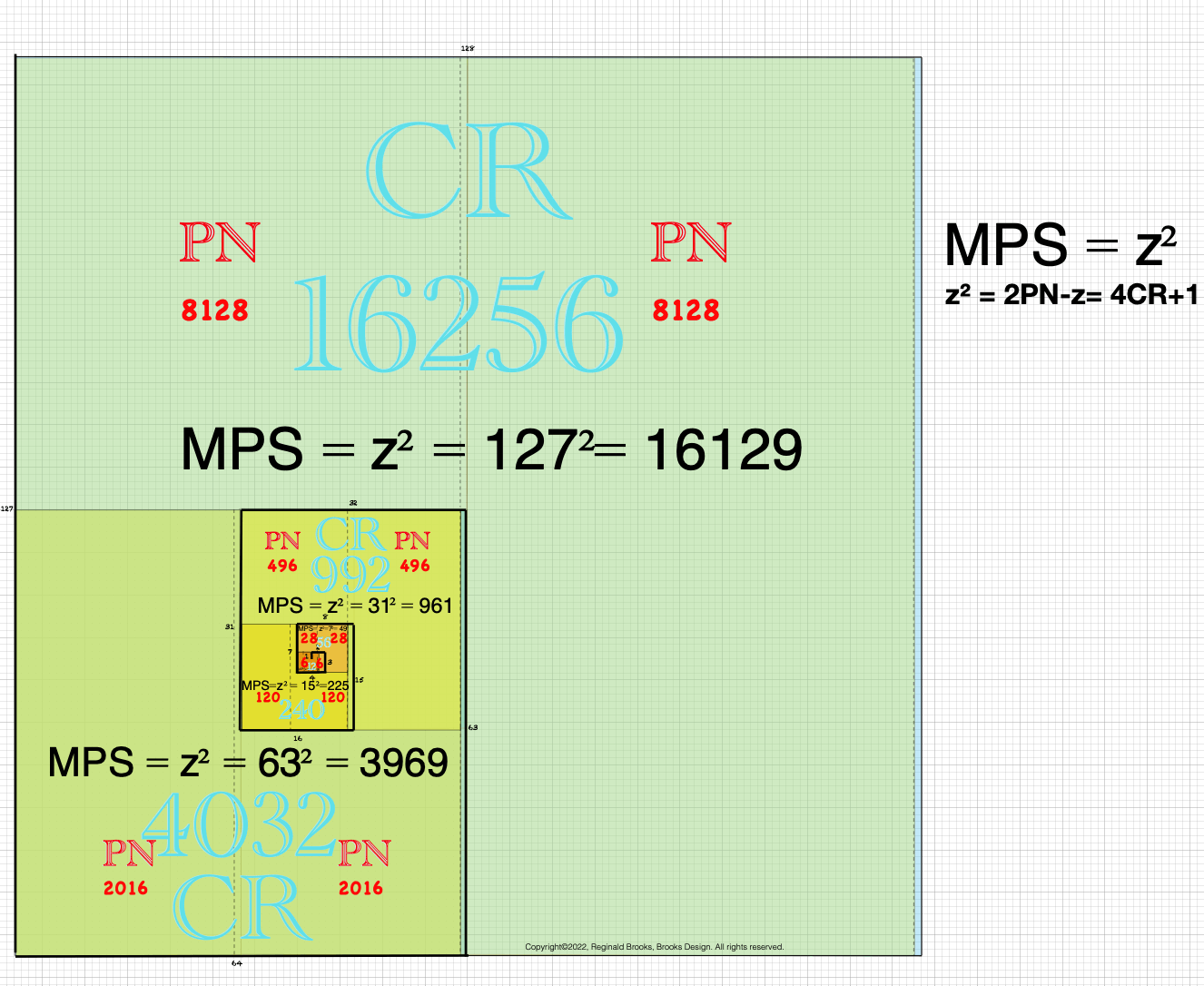
A subset of the Butterfly Matrix occurs in the whirling squares of the MPS.
The Mersenne Prime Square (z2) equals 2PN-z.
It also equals 4CR+1.
This happens as every CR=2PN.
Other interesting connections between the MPS and its parts will be shown later on in the advanced sections of BIMMPS.
A picture is worth a thousand words:
BFMatrix.gif

Make_BFM-19.pdf. With the doubling of the EVENS alternating on the Vertical Axis, place the Running Sums (∑) of ODDS alternating on the Horizontal Axis. Start with "1" then 1+2=3, 3+4=7, 7+8=15,... On the diagonals, place the product of the corresponding Axis cells. Label one diagonal CR, the other PN.

BIMMPS9.pdf

BIMMPS10.pdf

BIMMPS11.pdf

BIM-MPS_3DIAGONAL_Layout.pdf
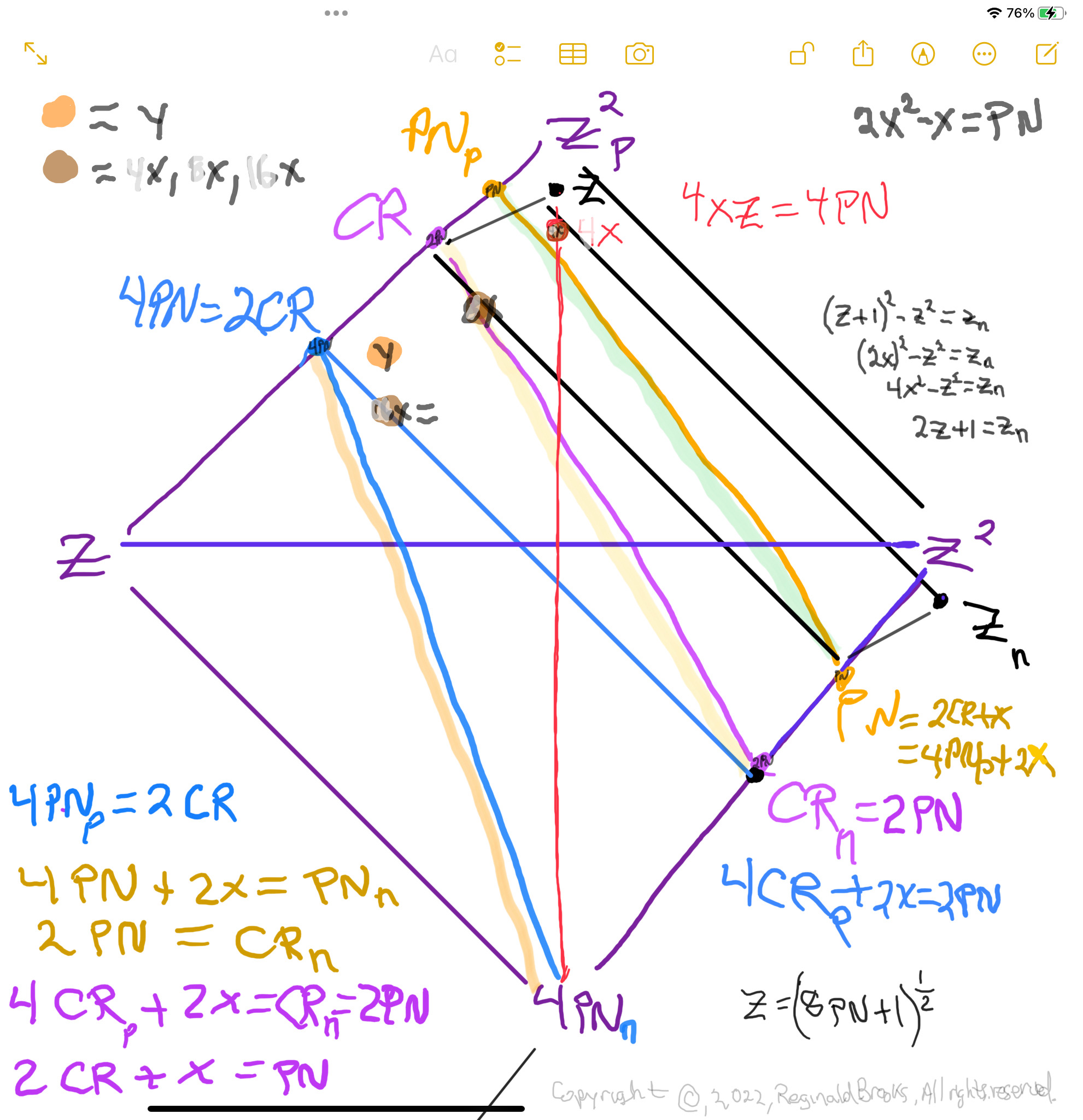
BIM150-MPS-10parametersAnnotate.jpg. Schematic of the 10-parameters within the Diamond-shaped MPS.
Transposing the Mersenne Prime Square (MPS) to a Diamond-shaped MPS (DMPS) on the BBS-ISL Matrix (BIM) reveals a whole new set of connections between the Mersenne Primes (Mp=z), Perfect Numbers (PN=x=2ᵖ⁻¹), Complement Rectangles (CR=xy, where y=x-1)… and their respective DMPS.
Every Mersenne Prime Square (MPS) when transposed to a Diamond shape (DMPS) on the BIM (BBS-ISL Matrix) will have this geometric configuration. While the numbers at the ends of each line may change (scale), they do so in a strictly fractal-ordered basis. The back edge informs the front edge — and — that front edge become the new back edge of the next larger DMPS, and so on.
Each subsequent DMPS is simply a larger fractal-based clone of its smaller (past) DMPS and informs its yet larger DMPS that follows (future). But they do this as Exponential Power of 2 — The Butterfly Fractal — “containers” as a necessary, but not sufficient, profile of a Mersenne Prime-Perfect Number, i.e. they are “containers” that hold all possible MPS, but only certain “containers” are actual Mersenne Prime-Perfect Number containers. The larger wave set is selectively interfered with the smaller wave set giving us the 51 known MP-PN.
Now here is something to scramble your mind — like Dylan’s lyric (Idiot Wind): “You’ll find out when you reach the top, you’re on the bottom.” — if the primes are the number atoms that all other composite numbers are made of, is not the above larger wave set that of the primes, the smaller set being the Exponential Power of 2?
Regardless, the fractal-based, relative relationship remains in tack — the one becomes the many.
The beauty of the numbers is that they give us all!
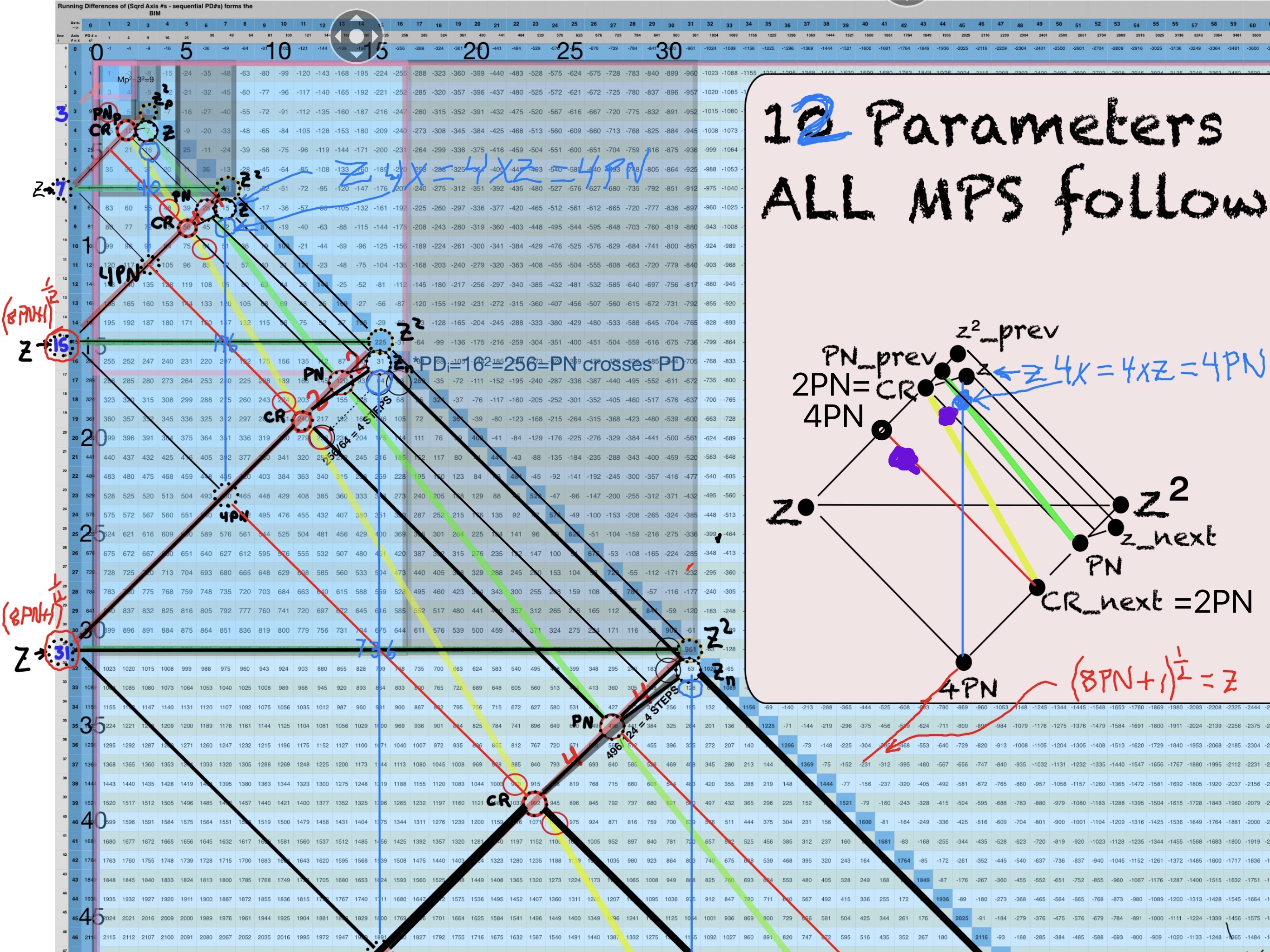
IMG_7457.jpg. Yes, there are actually more than 10 parameters, but it does get a bit busy!
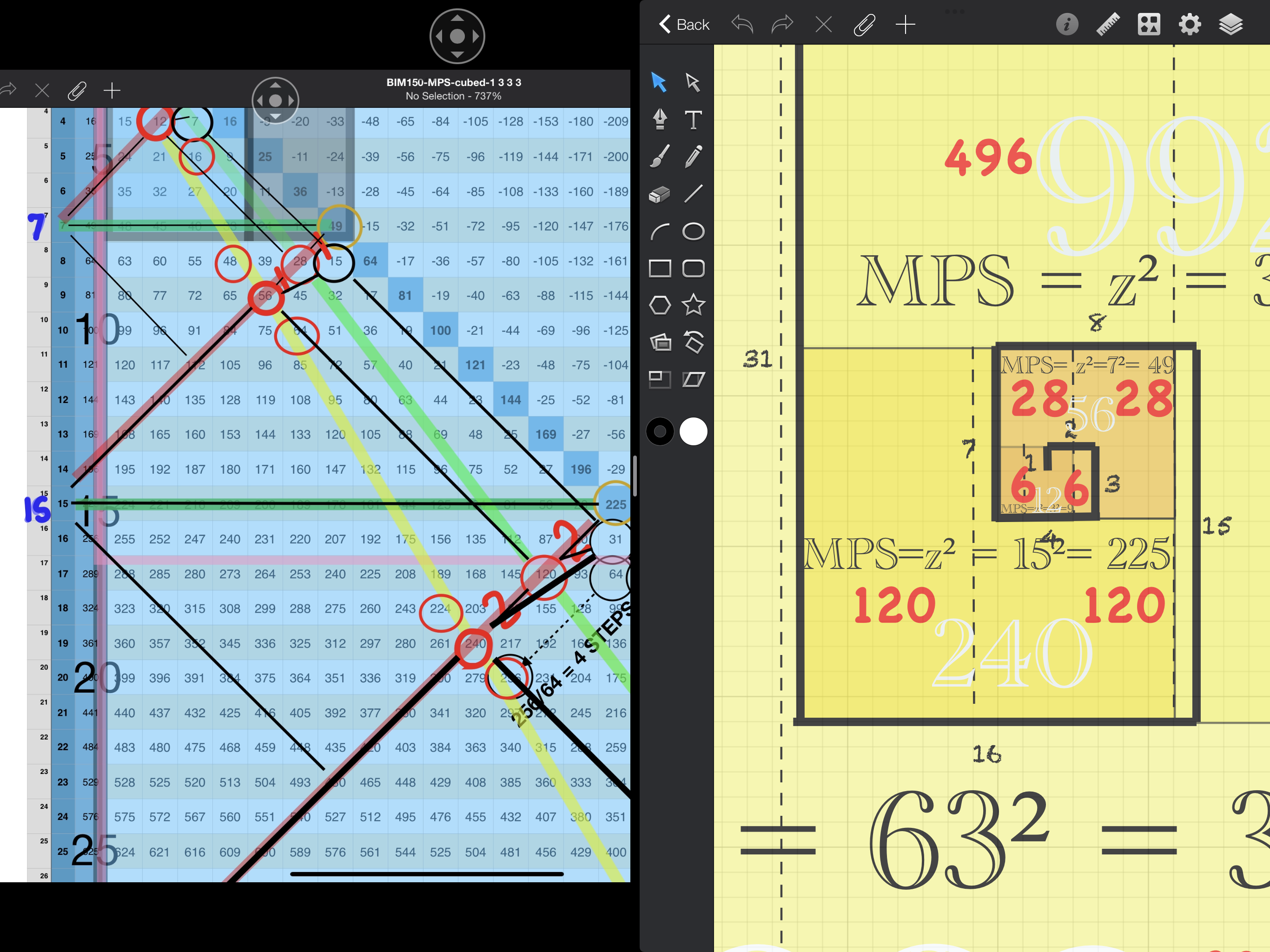
IMG_7271.png. Juxtaposing the BF Matrix next to the BIM shows how the former maps out on the BIM. Remember, every CR equals the doubling of the previous PN.
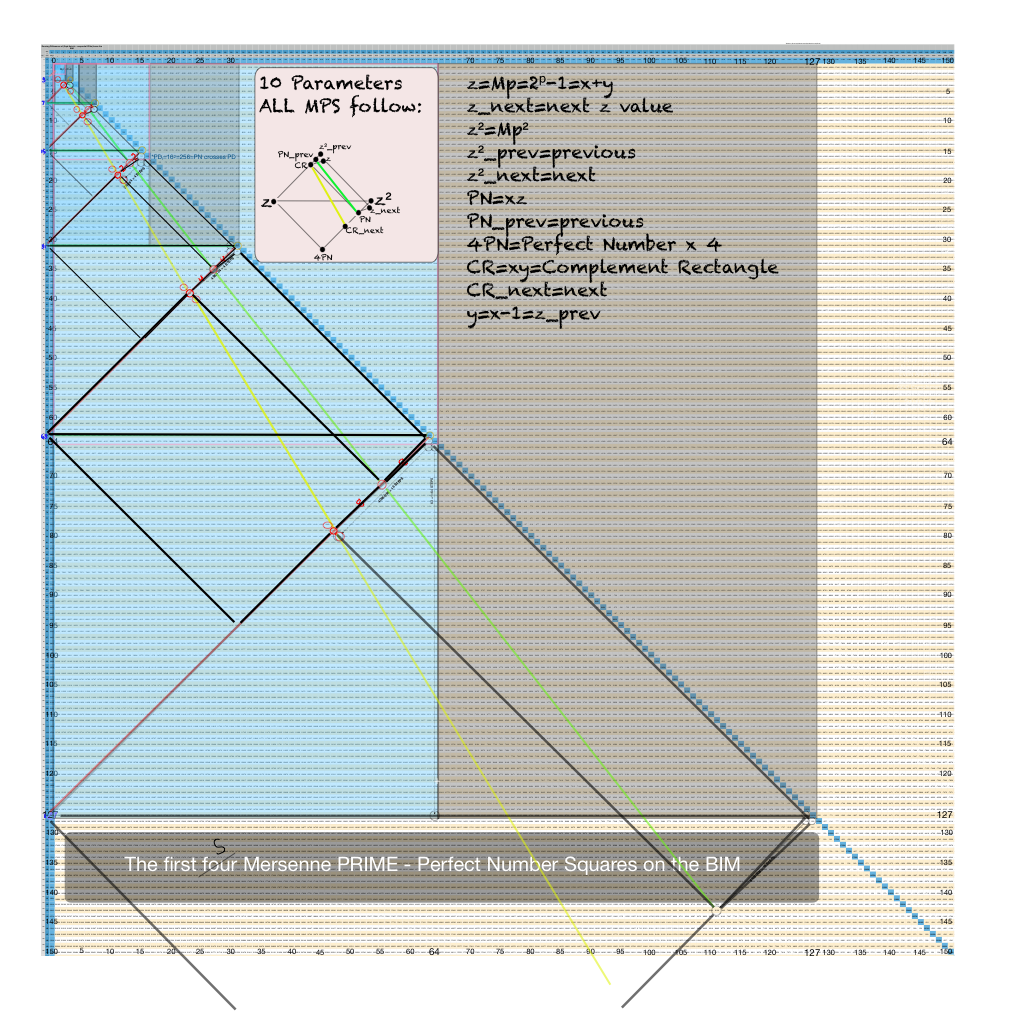
IMG_7266.png. Follow the pattern as each Diagonal that ends the previous (smaller) D-MPS becomes the start of the next (larger) one. The Number Pattern Sequence (NPS) remains the same for all D-MPS profiles.
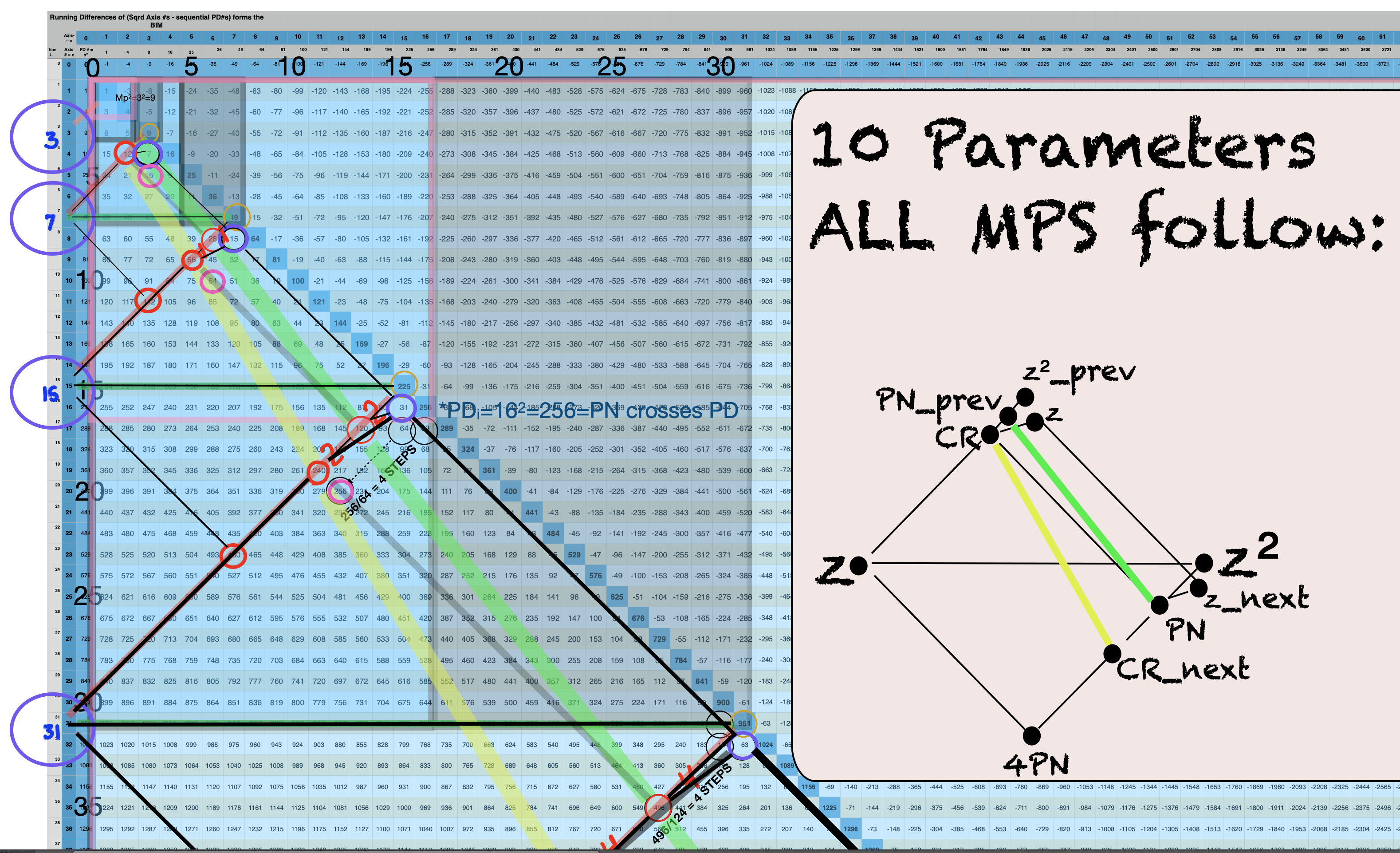
10parametersMPS_detail.png

10parametersMPS.pdf
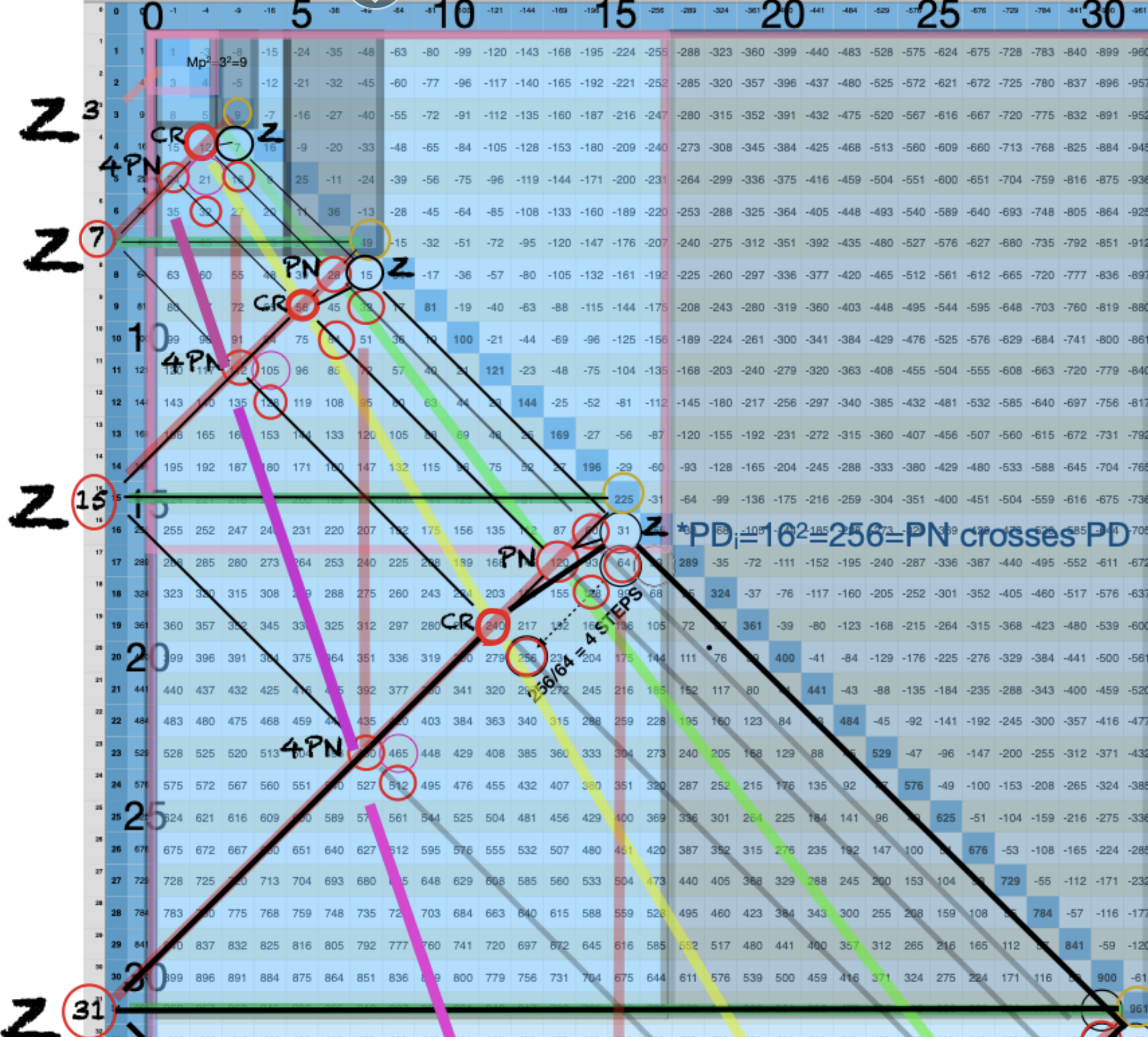
BIM150_10parameters0.jpg

BIM150-MPS-BF1_2.pdf

BIM150-MPS-10parameters+.pdf. Follow the pattern as each Diagonal that ends the previous (smaller) D-MPS becomes the start of the next (larger) one. The Number Pattern Sequence (NPS) remains the same for all D-MPS profiles.

BIM150-MPS-CRnext.pdf. The GREEN and YELLOW Diagonal lines show the NPS connection between subsequent D-MPS "containers," some that will be actual, true MPS. The "containers" are required in the sense that in their absence, the NPS of the actual, true MPS becomes increasingly vague and ultimately lost as the size grows.

BIM150_10parametersSchematic 2.pdf

BIM150-MPS-BF1.pdf
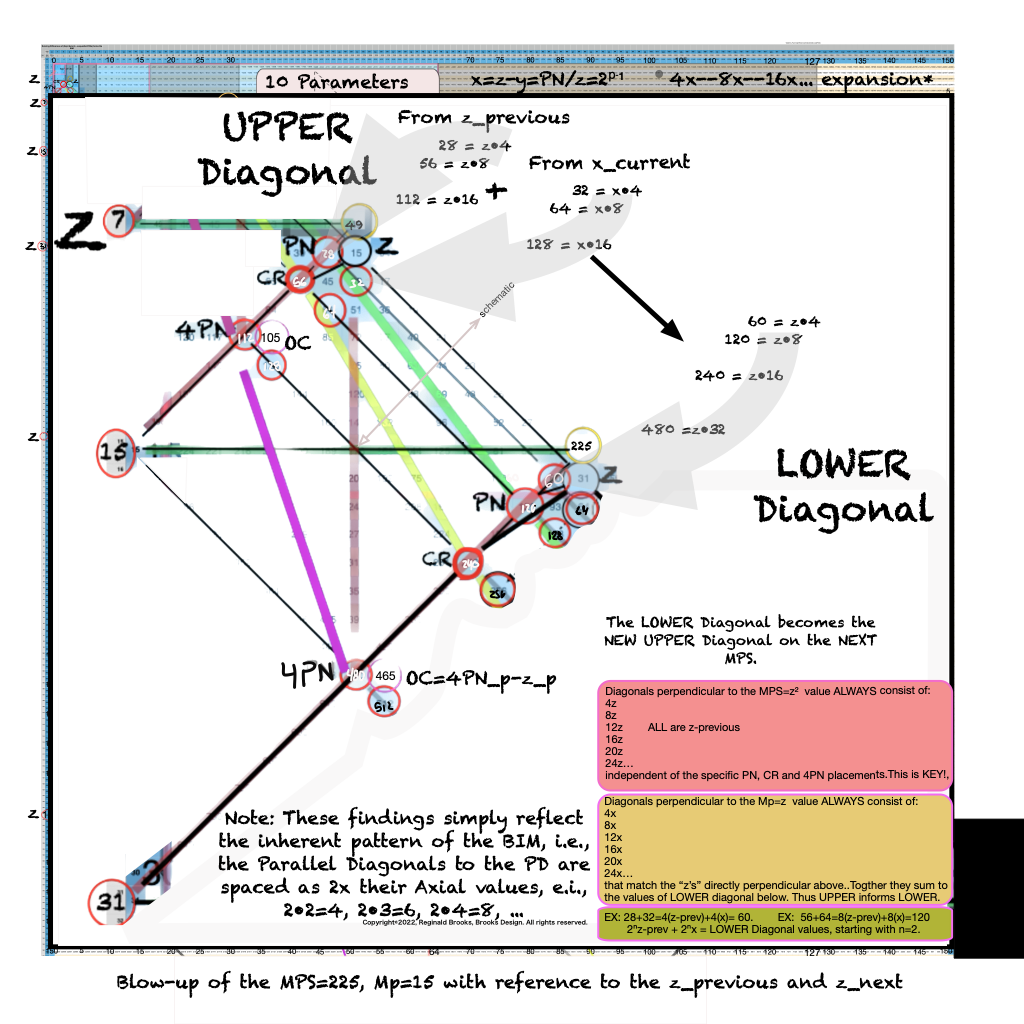
BIM150_10parametersSchematic 3.png

BIM150x150_PTOFBMPPN-DMPS.pdf. Preview of the details to follow in the next section: PTOFBMPPN.
Tables often contain enormous amounts of data and their connections to each other. While "Tables" will be presented in a later section, Table 132a-e (now we are looking at Tables 120-121) is worth a look now. Before resolving the geometries presented above, one connection after another of one piece of data tied to another kept coming up. It was only after placing it in table form did the more obvious solutions we see above come forth.
It is also that within the tables one sees the absolute requirement that ALL the "containers" be accounted for and included. The Number Pattern Sequences (NPS) of the MPS, Mp and PN parameters are dependent on this inclusion. And yes, this does mean including "p" values that are NOT Prime! That is the irony of the Primes to the Non-Primes, their NPS is not -- in any sense of the word -- obvious when treated as a separate group, but revealed within the larger set. One of the single most poignant revealations research on the Primes has brought out!
Speaking of "p" values: x=2p-1 which can be rewritten as x=2p/2. This translates to p=exponential that equals 2x as shown in the Tables 132 (Books IV and VI) below. For example: let x=4, then 2x=8, and 2p solves for 8 when p=3. Another example, knowing now that 2x=2p, let's try it with x=64, then 2x=128=2p when p=7. Do remember that the "p" value also gives the number of fractal doubling levels for each respective Mp-PN-MPS set, e.i. if p=3, then there are 3 levels of R∑.
One can also solve for "p": As 2p=2x, take the logarithm of both sides, fill in the value of "x" and solve as p = ln(2x)/ln(2).
p = ln(2x)/ln(2)
If you are starting with x2 then use this:
p = [ln(x2)/ln(2)]+1
End of "Previously in Book IV:"
~~~ ~~~ ~~~ ~~~ ~~~ ~~~ ~~~ ~~~ ~~~ ~~~ ~~~ ~~~ ~~~ ~~~ ~~~ ~~~ ~~~ ~~~ ~~~ ~~~ ~~~ ~~~ ~~~ ~~~ ~~~ ~~~ ~~~ ~~~ ~~~ ~~~ ~~~ ~~~
PTOFBMPPN
The Periodic Table Of Fractal-Based Mersenne Prime - Perfect Numbers is a keystone table in the sense that it can unlock so many of the interconnections between the basic Butterfly Fractal and the 10 component parameters of every MPS -- both the active, true and the active, but "container-only" resonant forms.
Perhaps the single most constant challenge throughout the entire BIMMPS discovery process has been keeping track of those 10 parameters. Why? Because of their immense overlap. y is simply x-1, y in "containers" becomes z in active, true MPS. x becomes x2 and when doubled +1 becomes z, x+y=z and xy=CR, and x and z are just manifestations of p (less one). And it goes on and on.
But there is a reason. It results from them being the products of the interference pattern of Butterfly Fractal that informs them all!
To start, we will show where this PTOFBMMPNs is going -- right straight to BIM!
Don't worry, we will then be going on a little journey to see how we got there.
If a picture is worth a thousand words, a table just might be worth a thousand pictures!

BIM150x150_PTOFBMPPN-DMPSlayer5--+.pdf
Yes, that is intricate. The steps getting there are much simpler.

Table121_PTOFBMPPN-2.pdf. Here is the PTOFBMPPN, longer form.

Table120_PTOFBMPPN.pdf. Here is the PTOFBMPPN more manageable short form. The table reveals the next-z values. The current "z" times "x" would equal xz=PN=2p-1(2p-1), but we will also ADD the "y" value to gives us z-next. In subsequent versions of the PTOFBMPPN we will eliminate the "y" addition, giving us a table of next PNs.
It is also that within the tables one sees the absolute requirement that ALL the "containers" be accounted for and included. The Number Pattern Sequences (NPS) of the MPS, Mp and PN parameters are dependent on this inclusion. And yes, this does mean including "p" values that are NOT Prime!
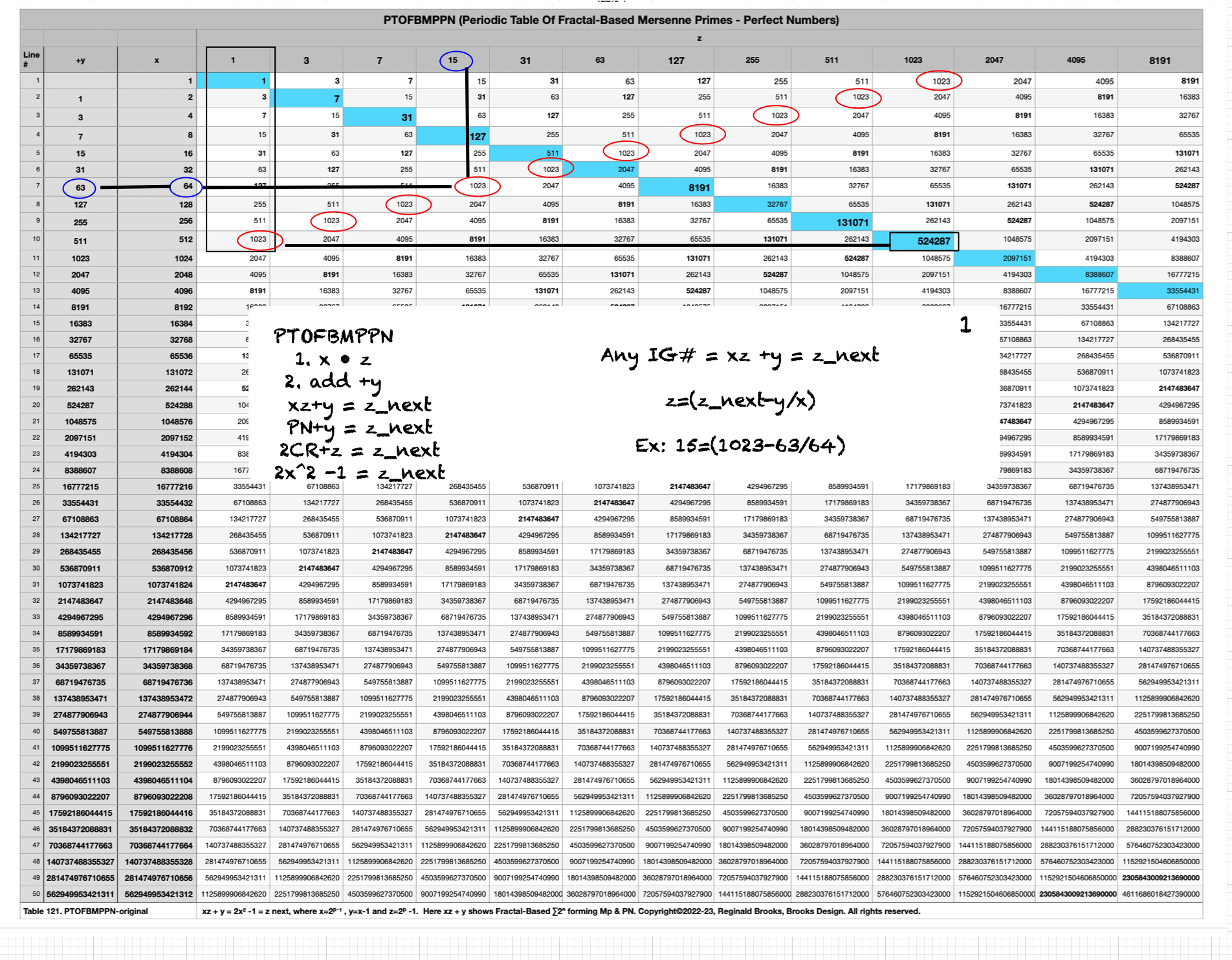
PTOFBMPPN-1.gif.
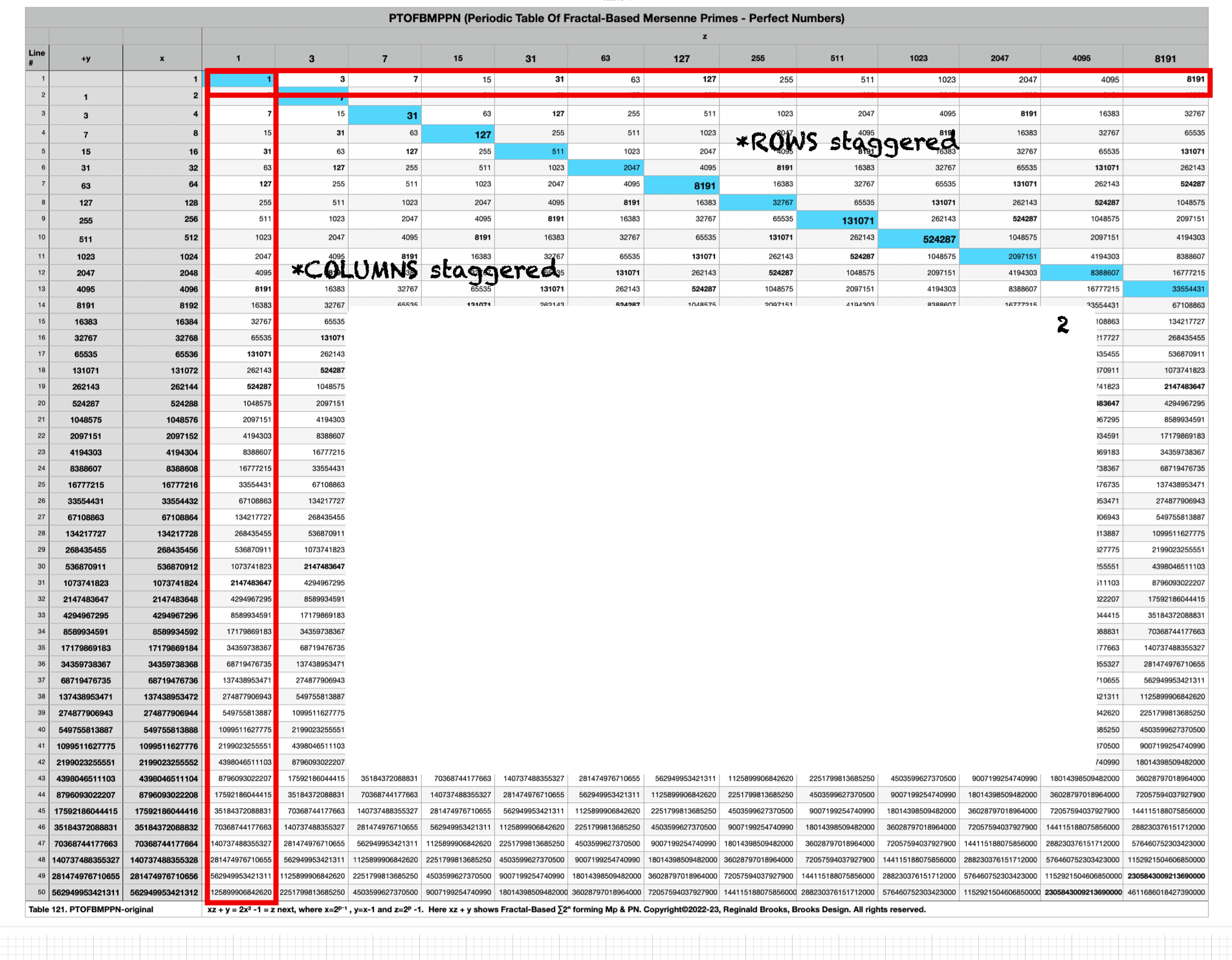
PTOFBMPPN-2.gif. The fractal-based table is nothing if not a staggered reiteration of every column and row!
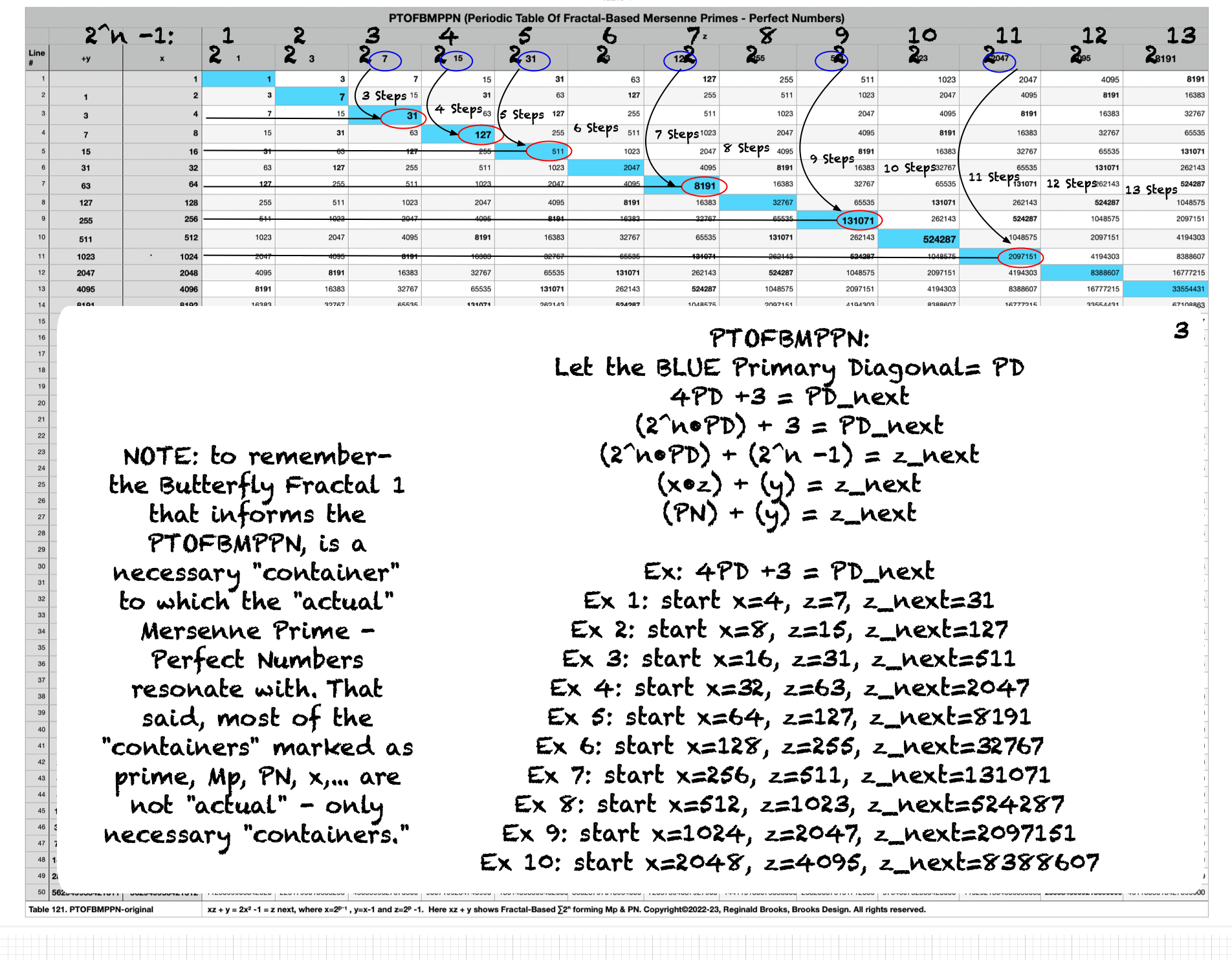
PTOFBMPPN-3.gif
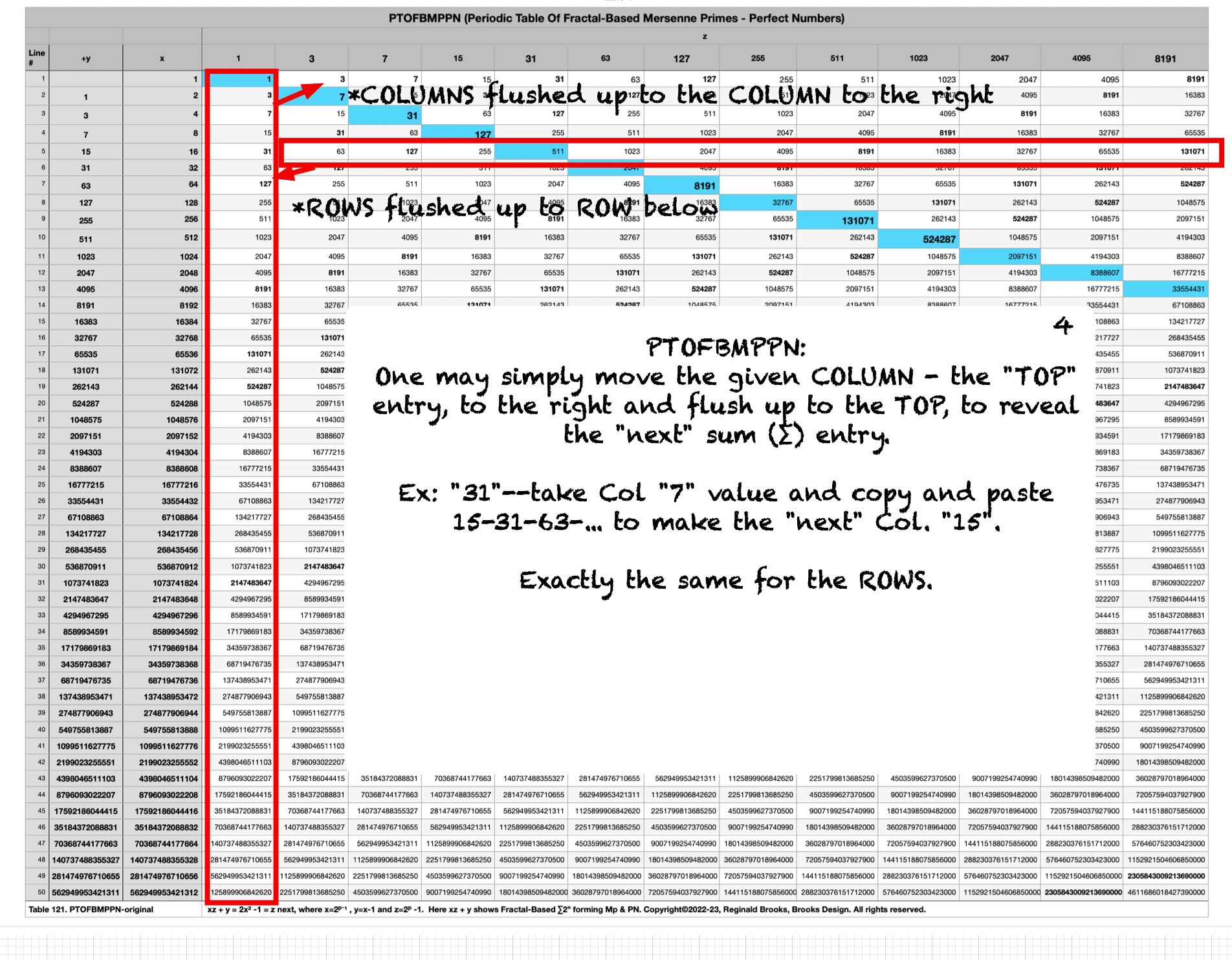
PTOFBMPPN-4.gif
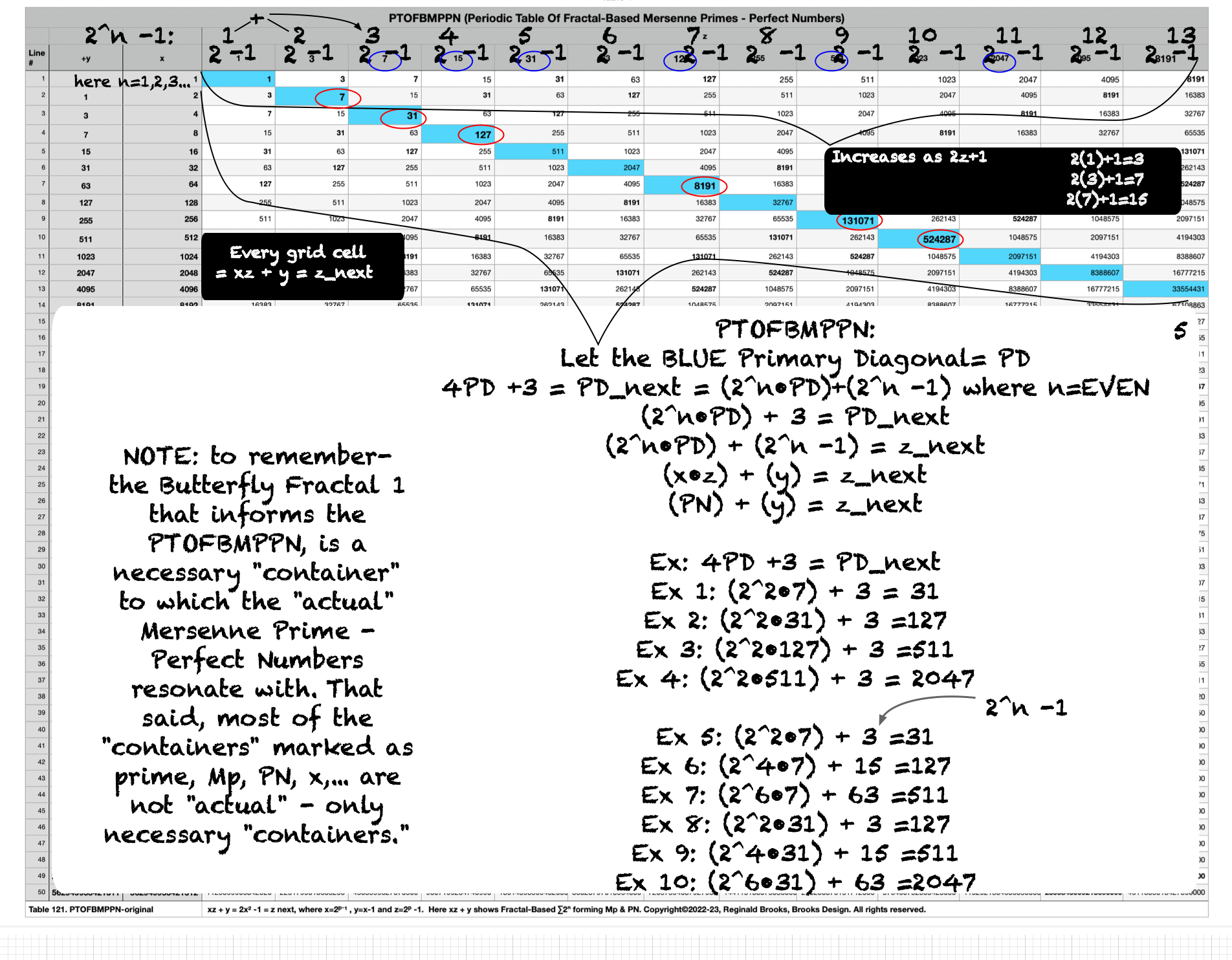
PTOFBMPPN-5.gif
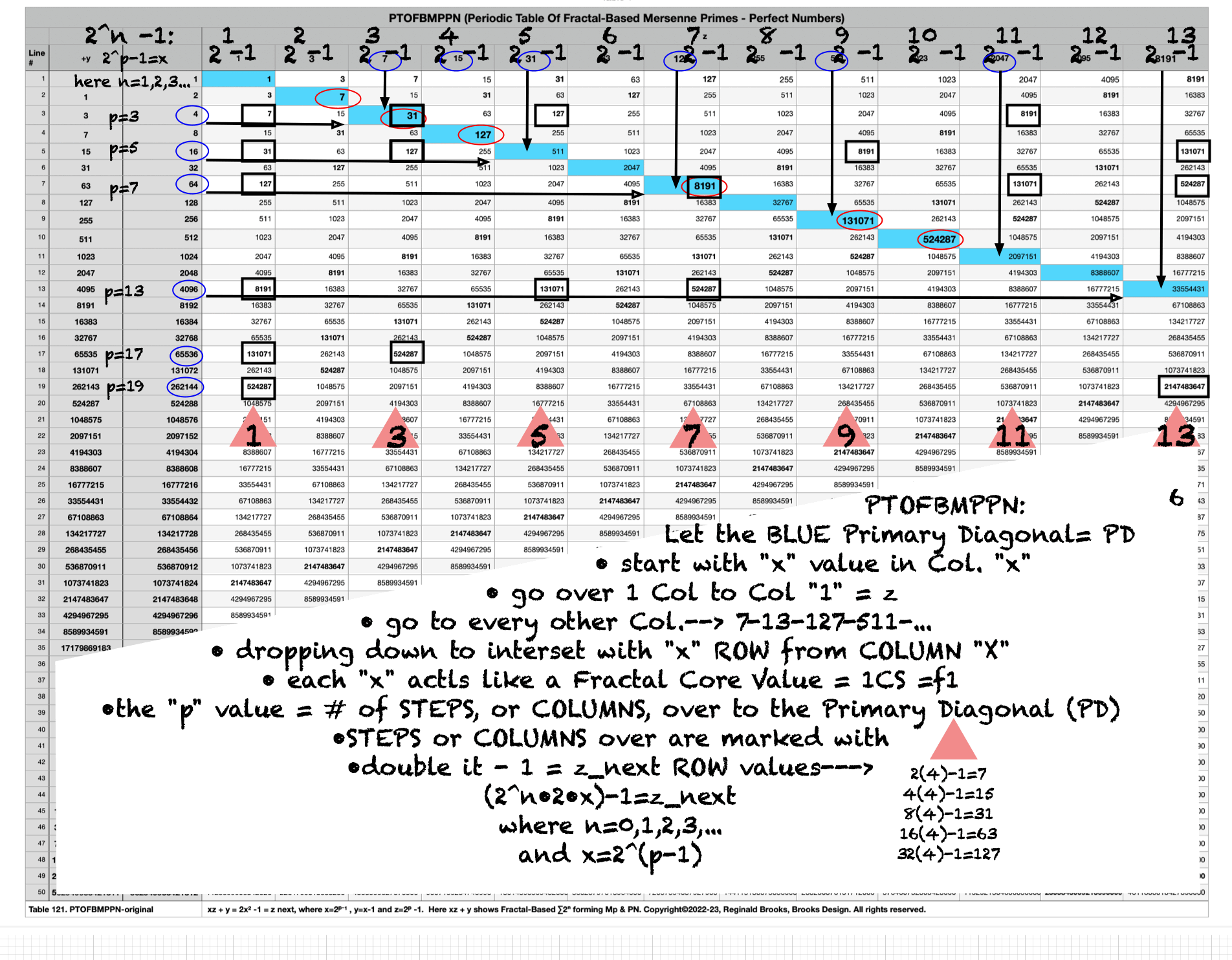
PTOFBMPPN-6.gif
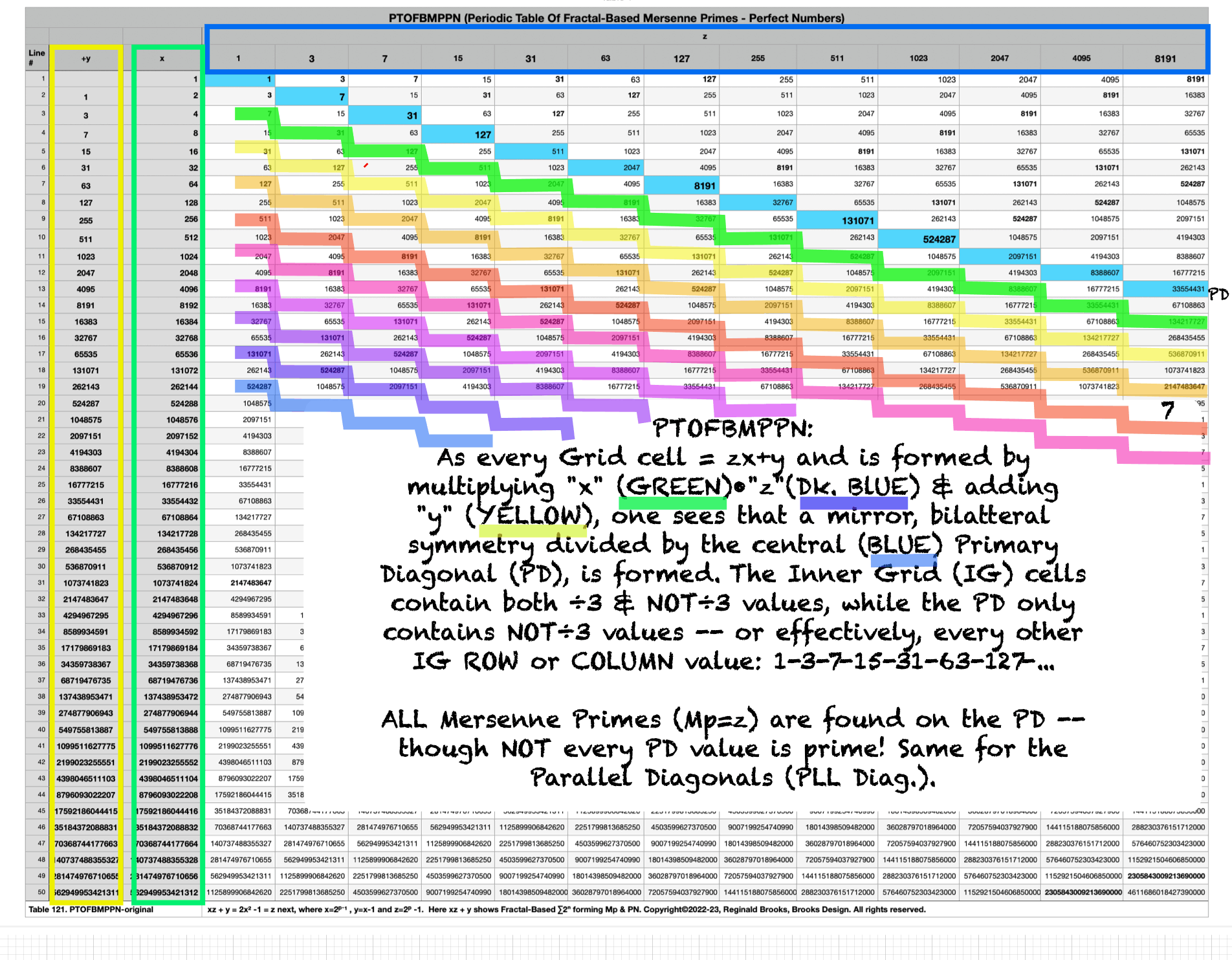
PTOFBMPPN-7.gif
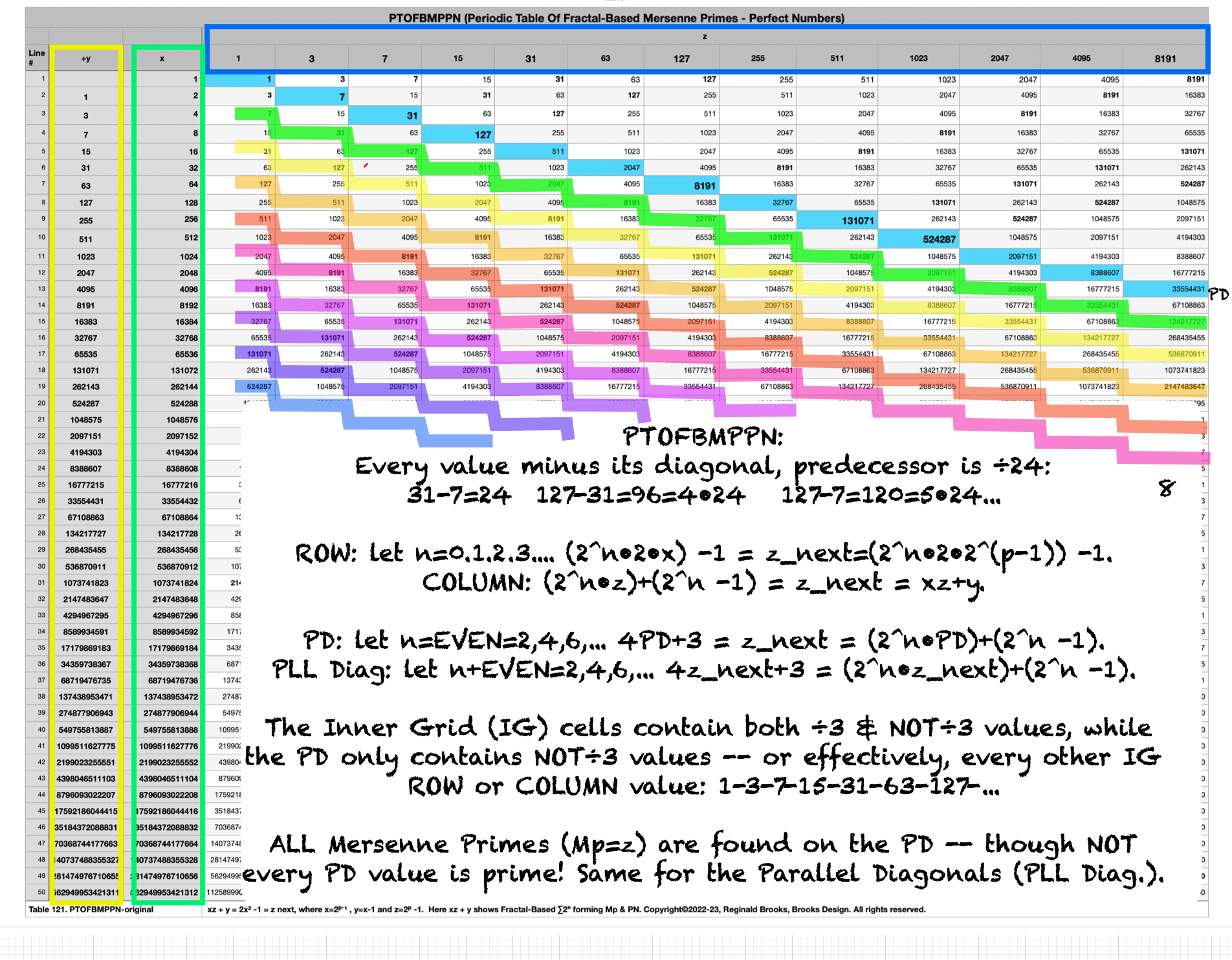
PTOFBMPPN-8.gif
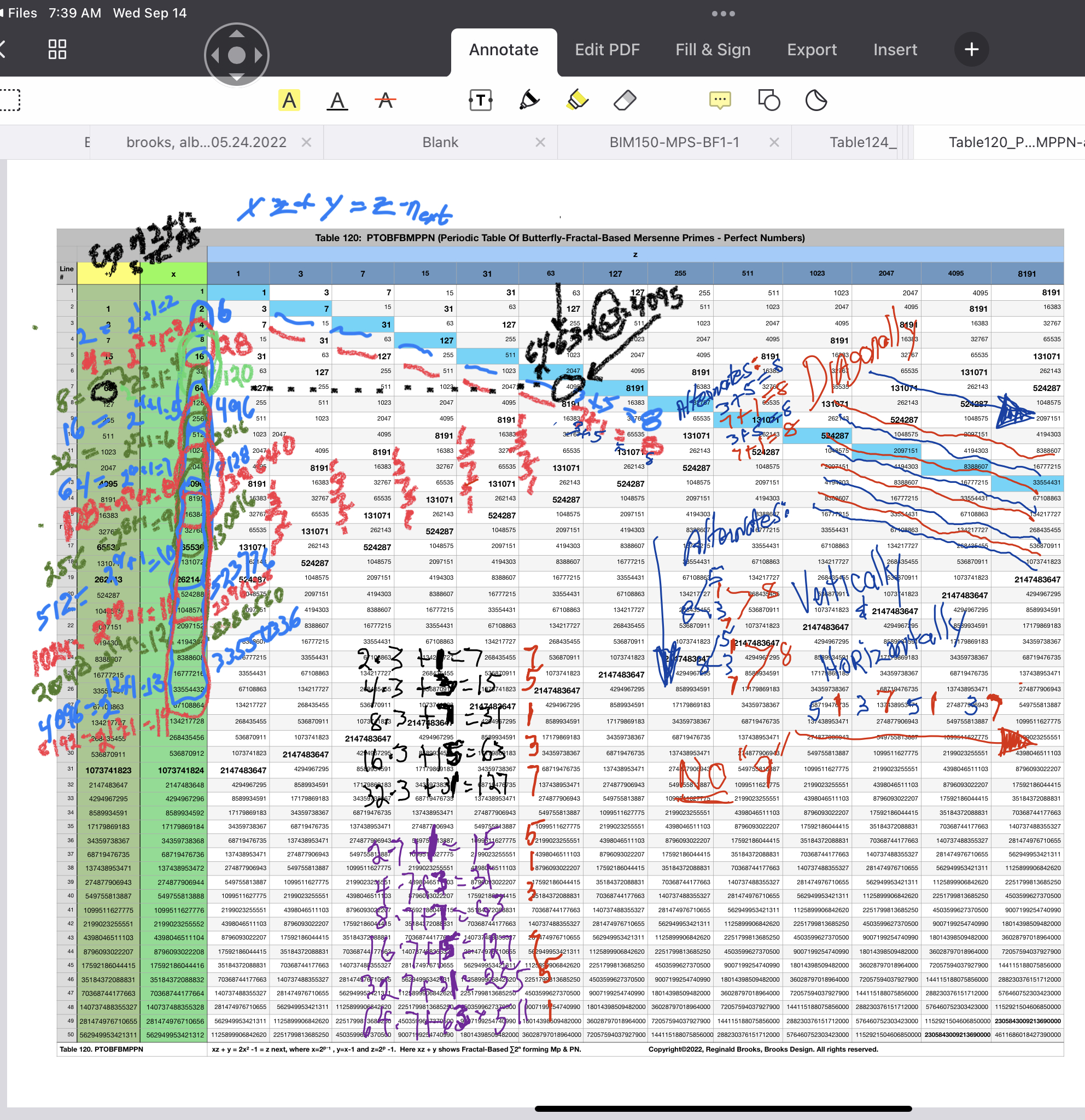
PTOFBMPPN-9Anot.jpg. Yes, this messy annotation is a work in progress. It is primiarily about the NPS ending numbers that each z-next takes in Rows and in Columns.
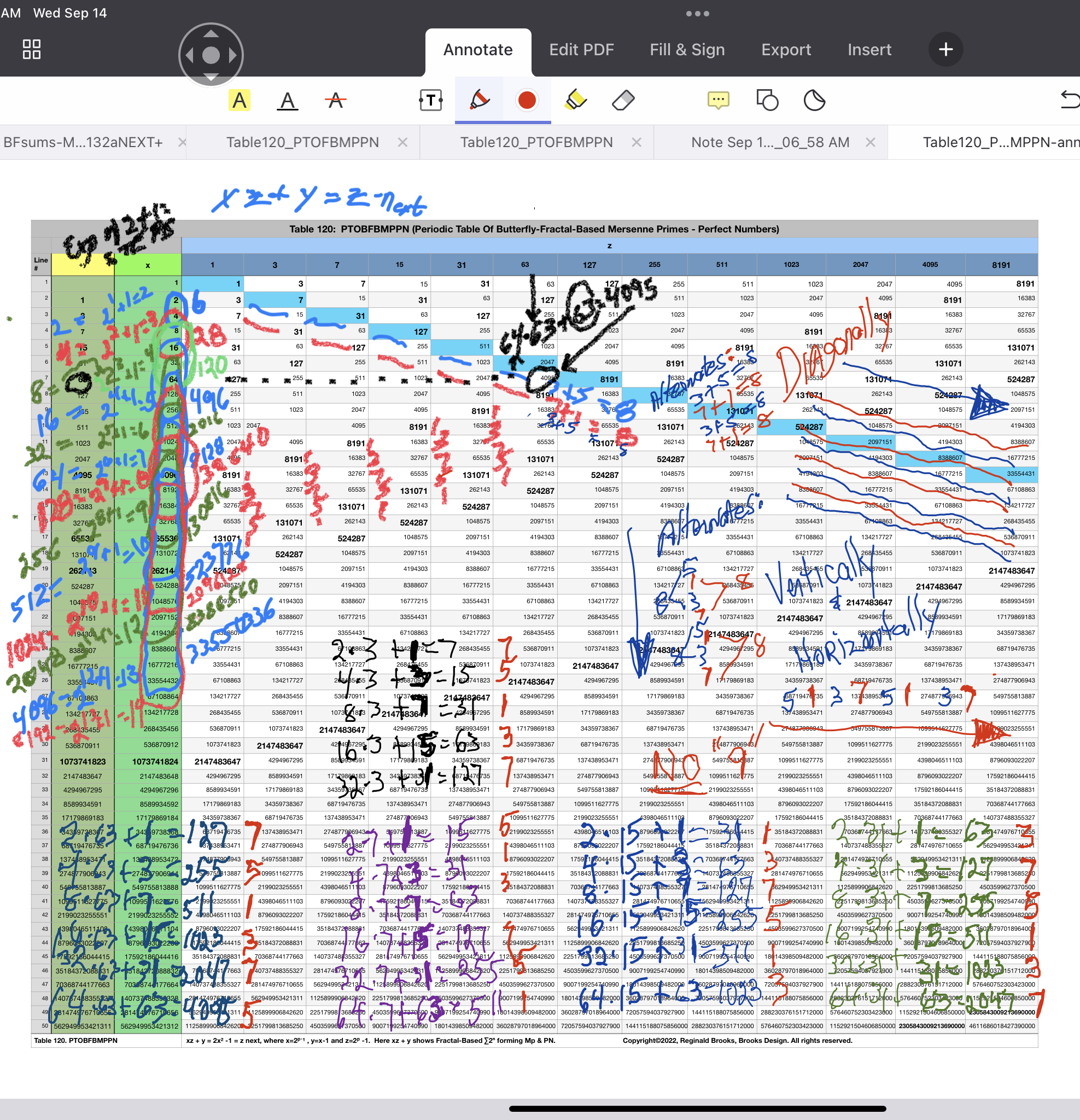
PTOFBMPPN-10Anot.jpg. Yes, this messy annotation is a work in progress. It is primiarily about the NPS ending numbers that each z-next takes in Rows and in Columns.
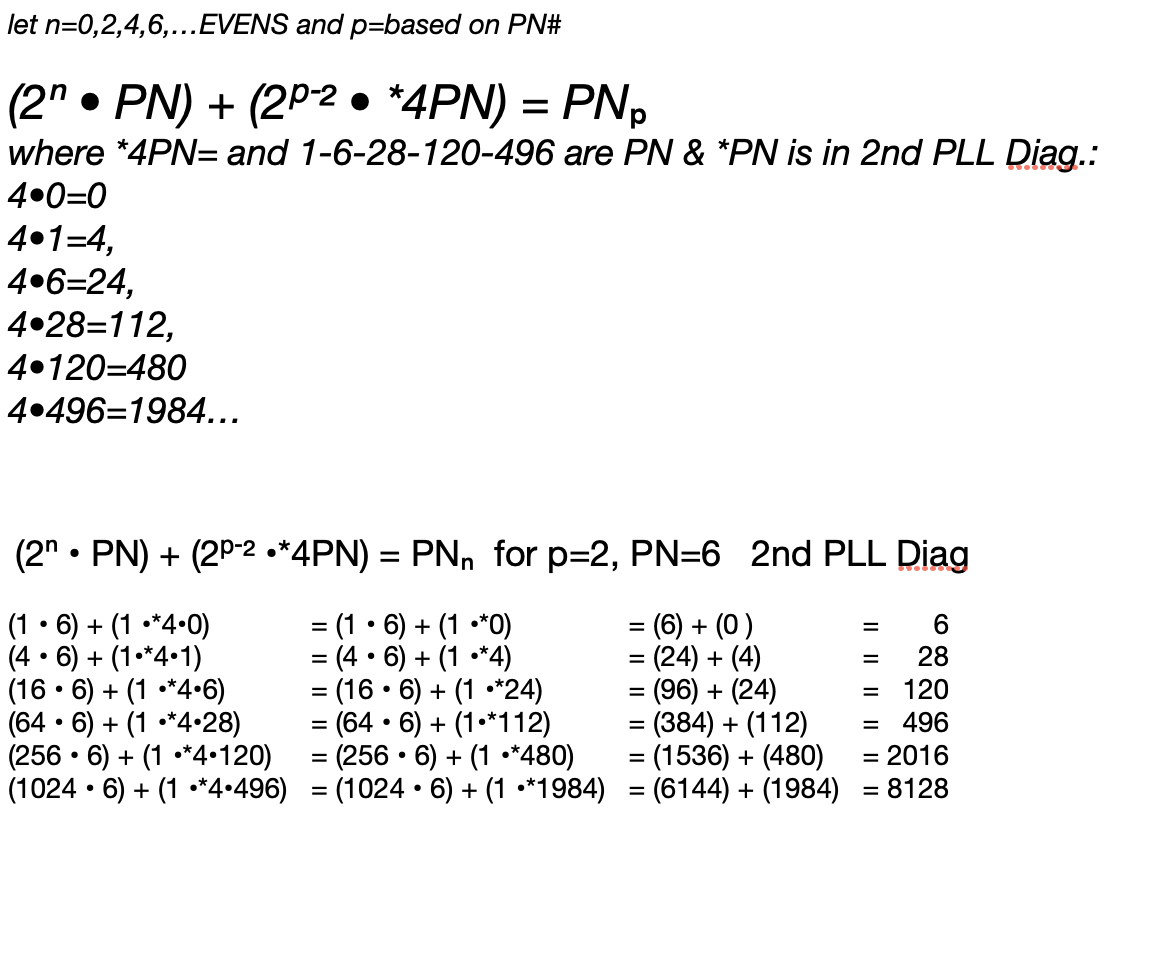
PTOFBMPPN-11-y-1.png. Here are some equations for getting the next-PN. They will be included with the PTOFBMPPN further down. PPL Diag.= Parallel Diagonal (1,2,3,...) from the Primary Diagonal (PD).
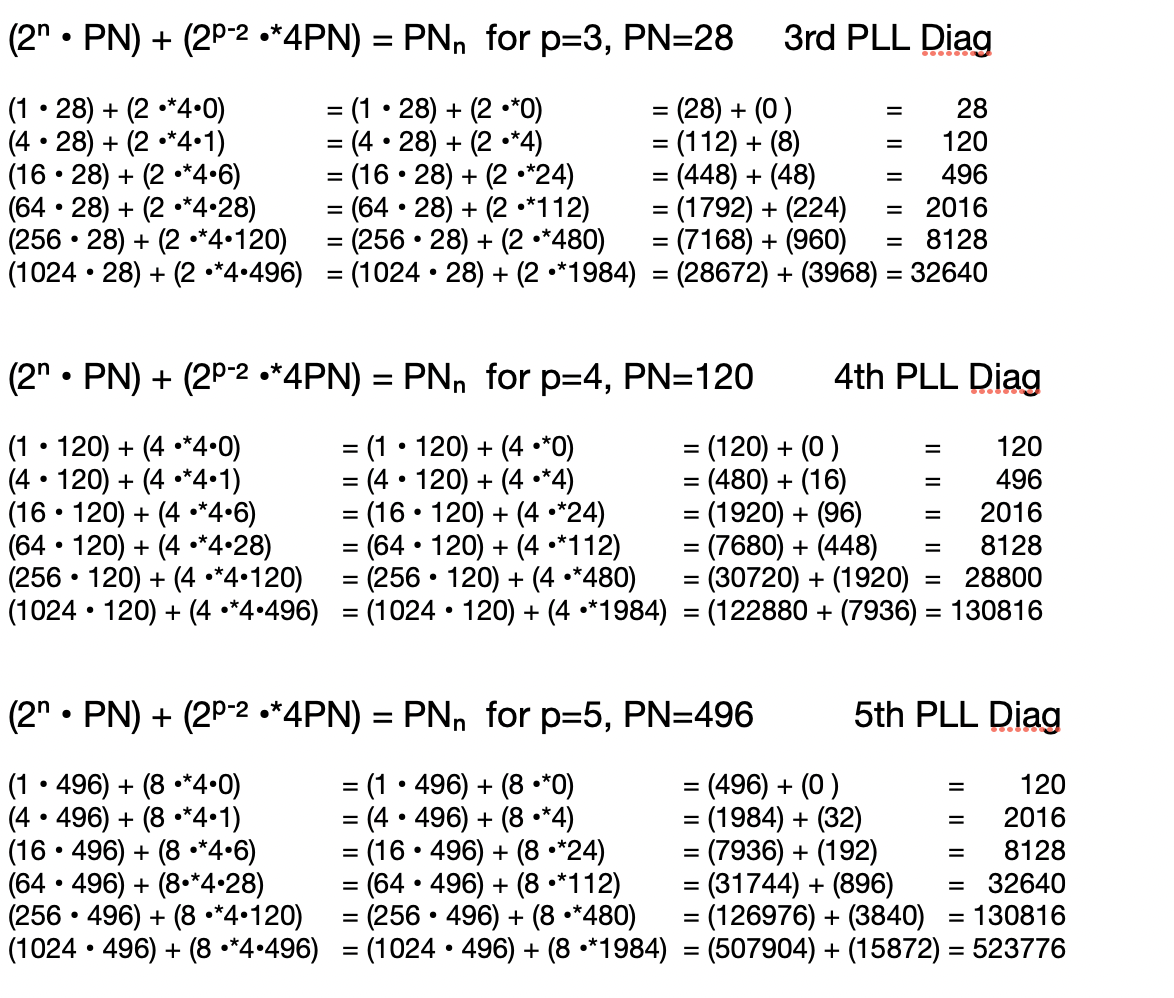
PTOFBMPPN-11-y-2.png
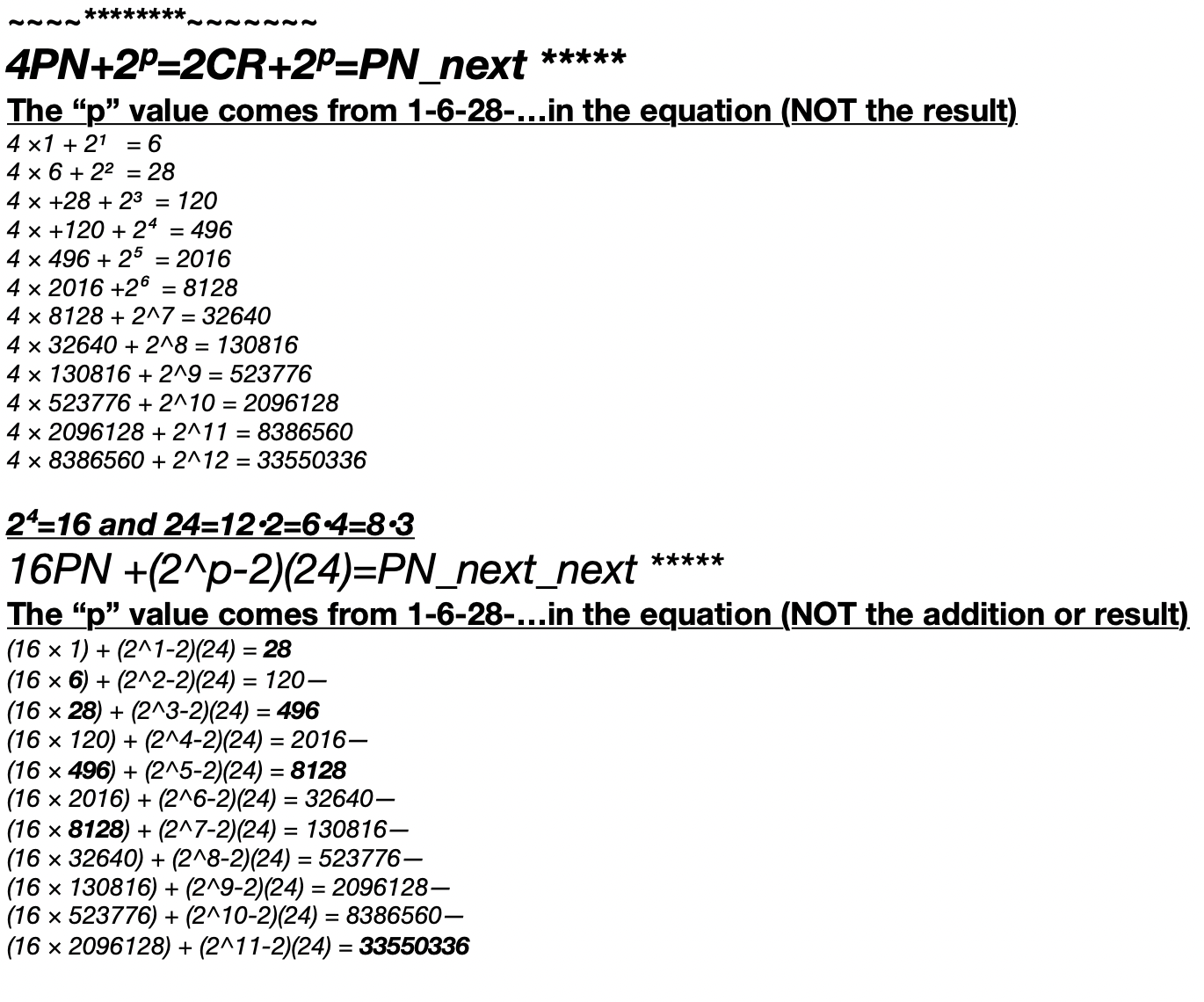
PTOFBMPPN-11-y-3.png
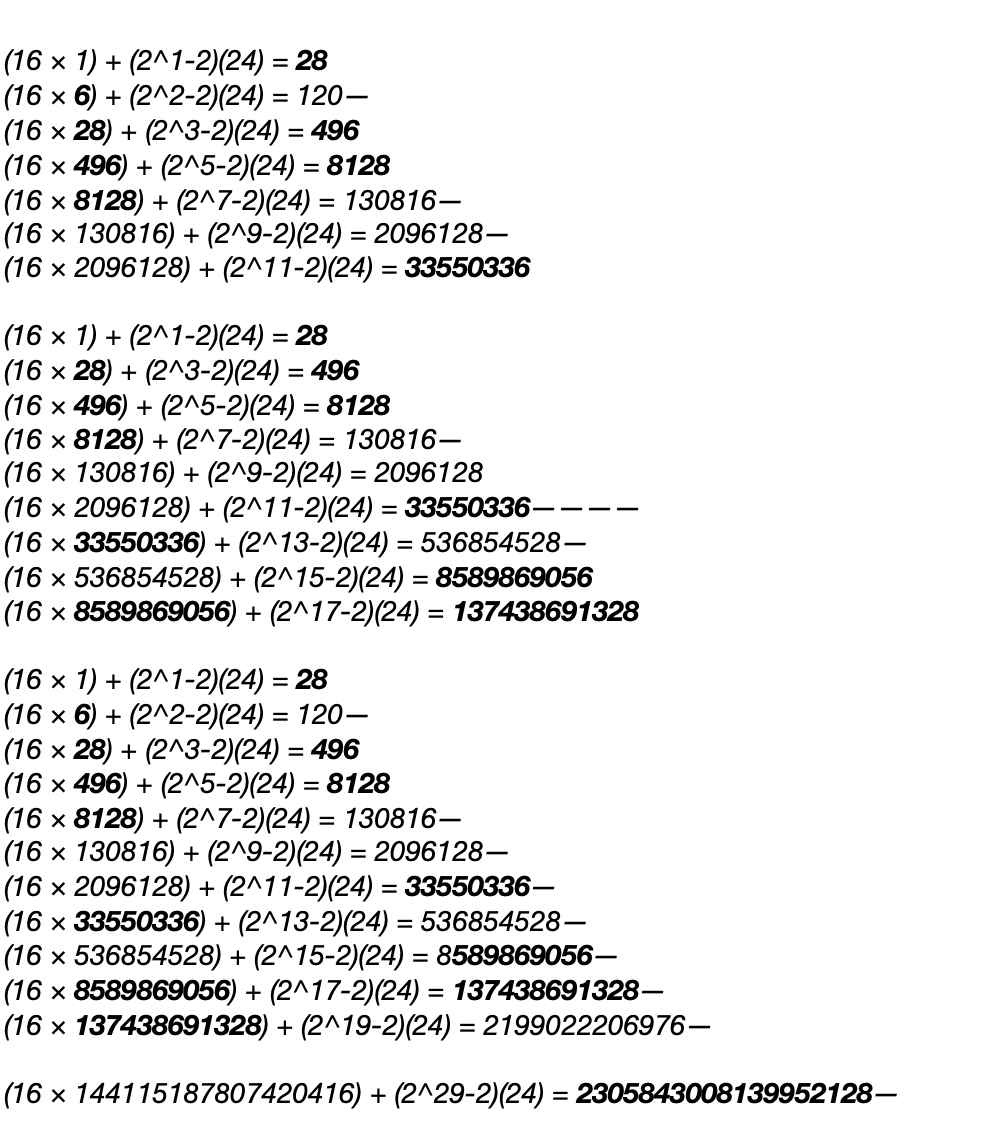
PTOFBMPPN-11-y-4.png
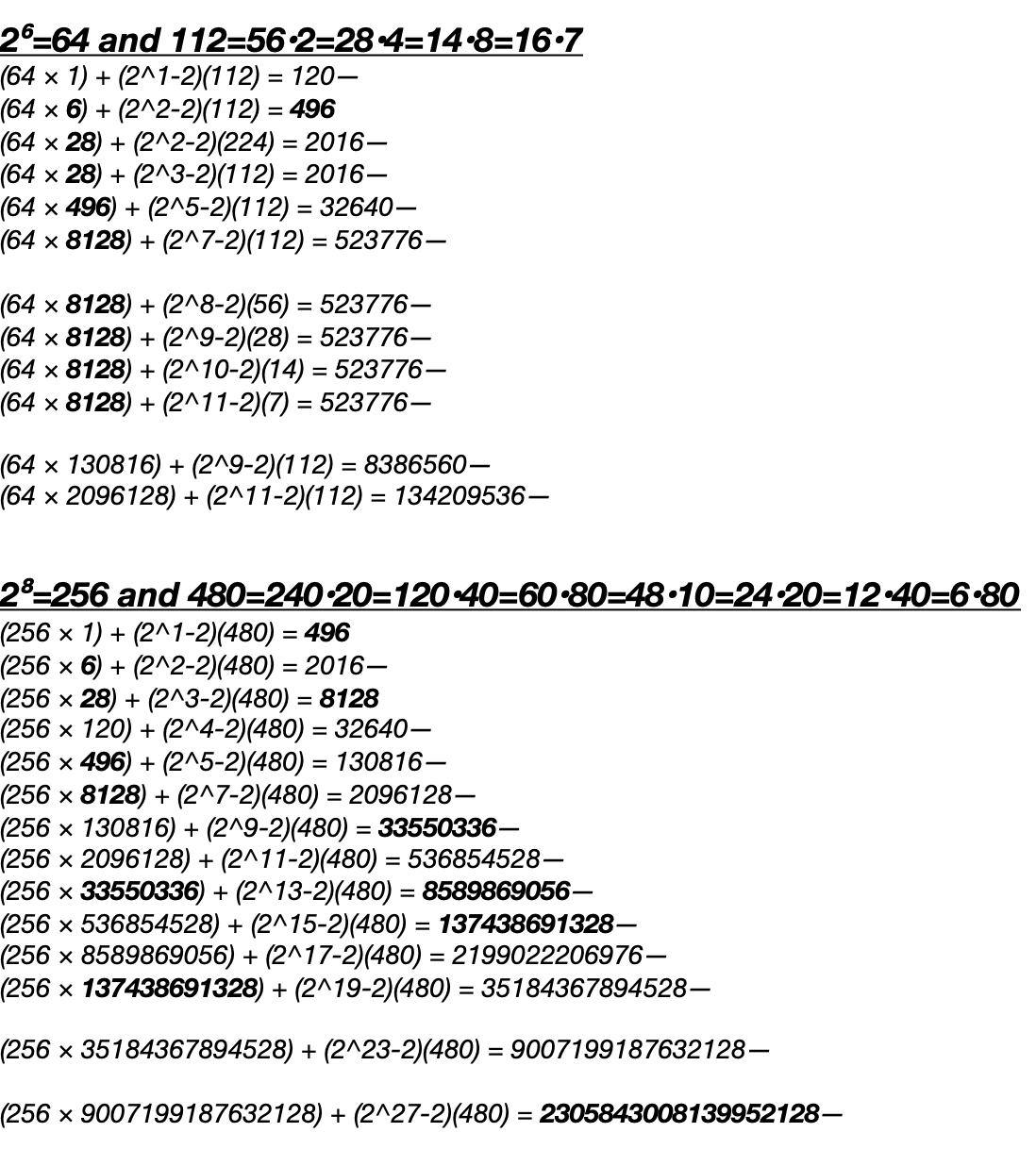
PTOFBMPPN-11-y-5.png
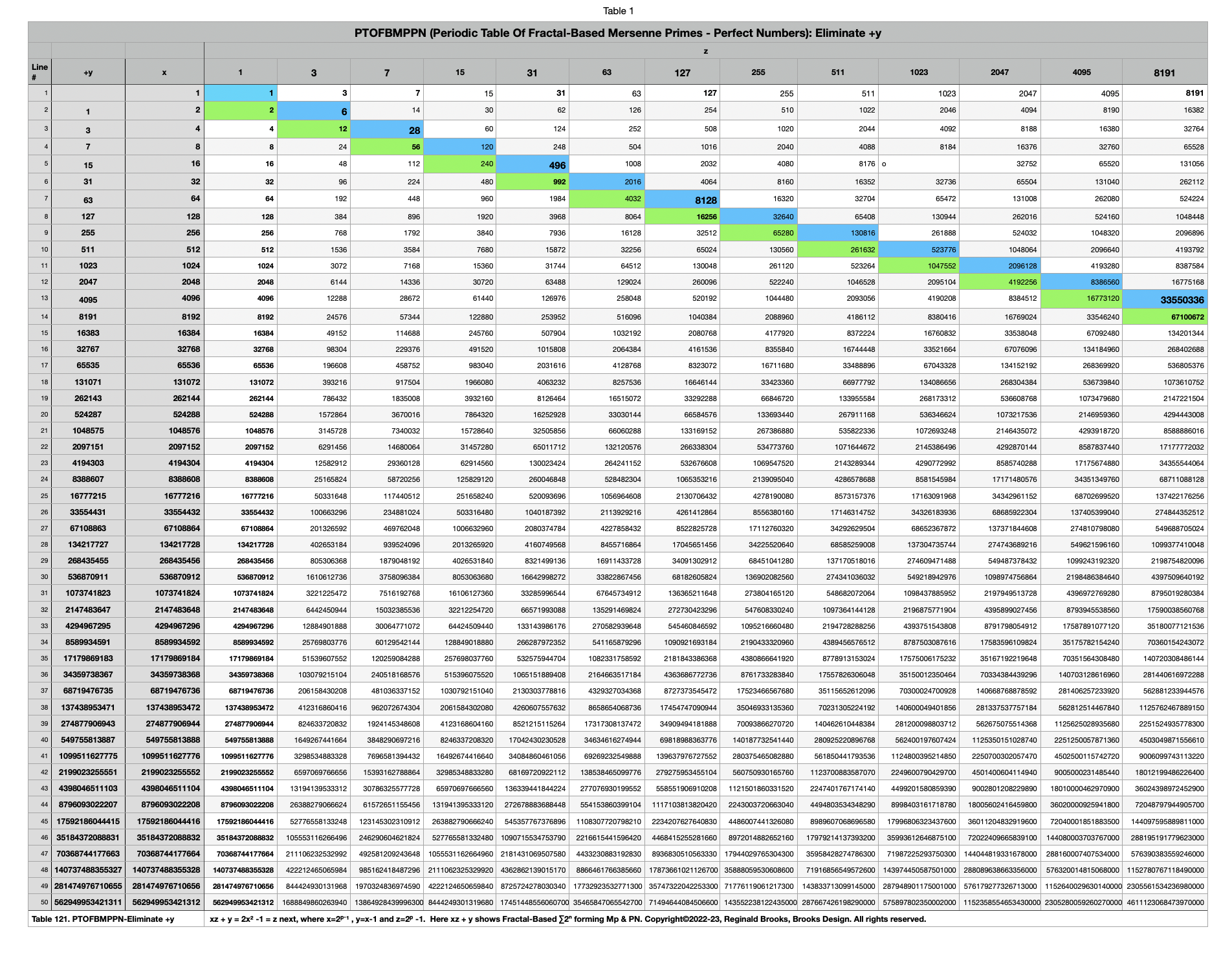
PTOFBMPPN-11-y.png. Eliminate "y" and you get the PTOFBMPPN of next-PNs.
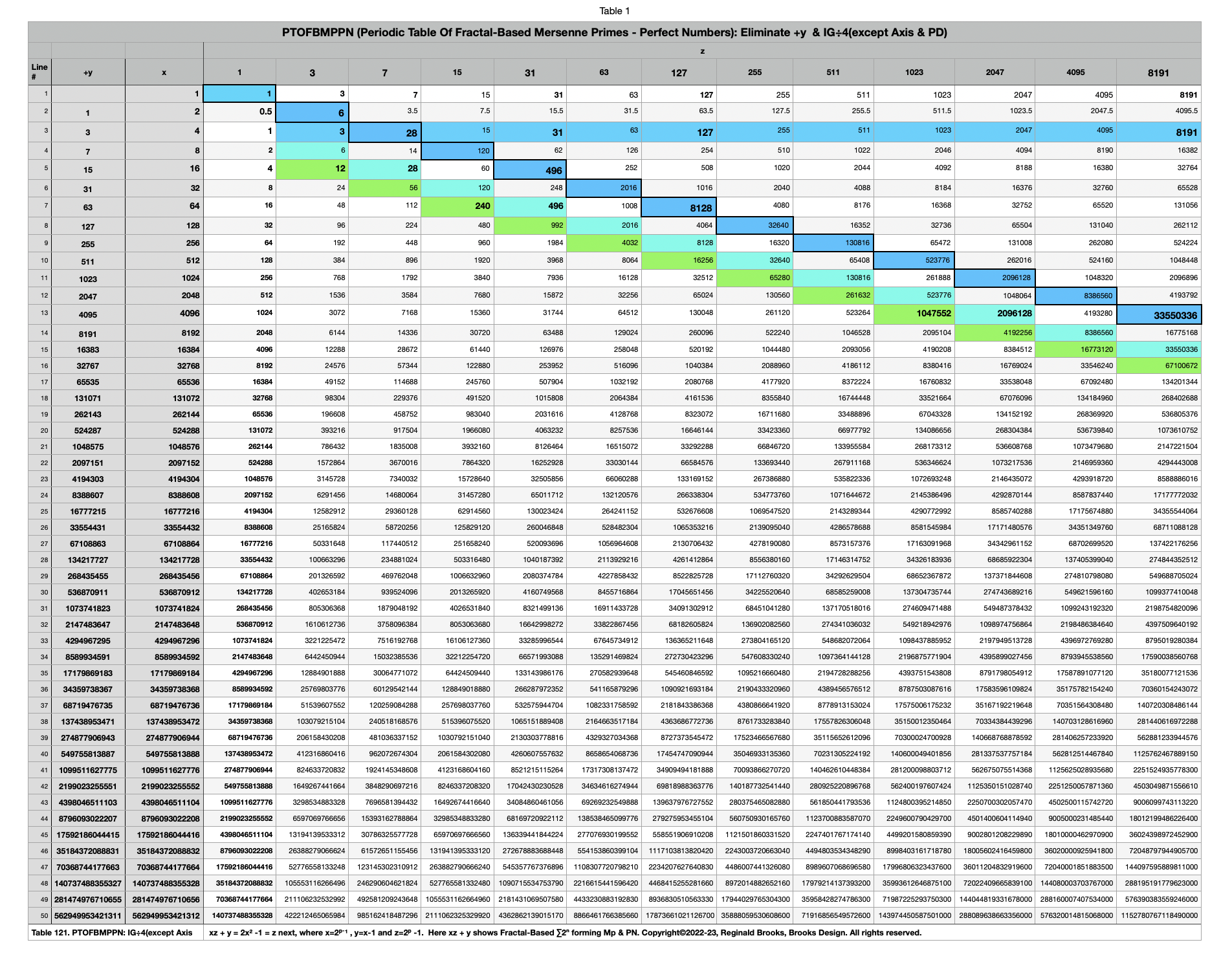
PTOFBMPPN-12-y_divide_4.png. . Eliminate "y" and you get the PTOFBMPPN of next-PNs. Then, except for the PD and Axis, now divide by 4.

PTOFBMPPN-13Anot.jpg
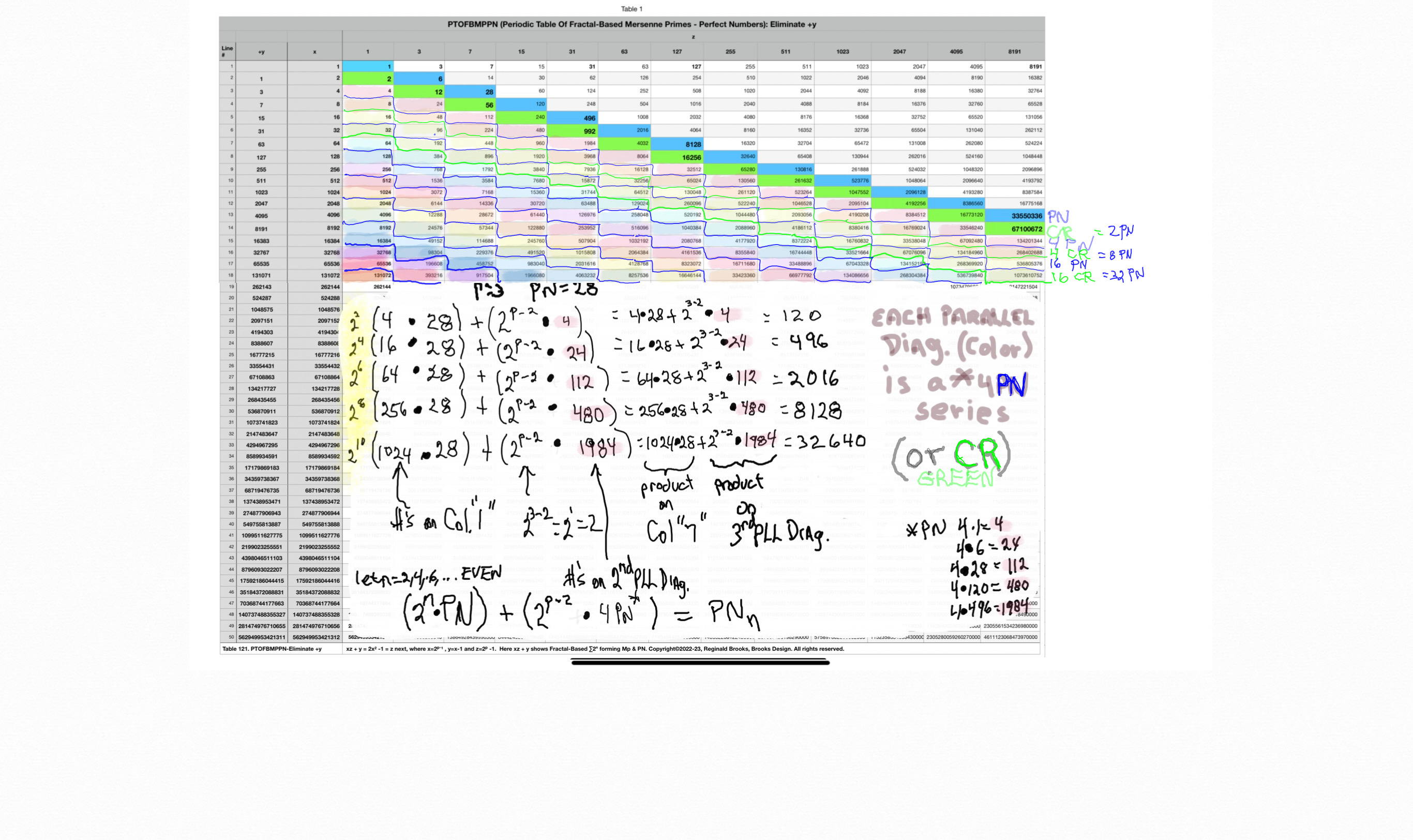
PTOFBMPPN-14Anot.jpg. Each Parallel Diagonal (COLOR) is a 4PN (BLUE) or a CR (GREEN) result.
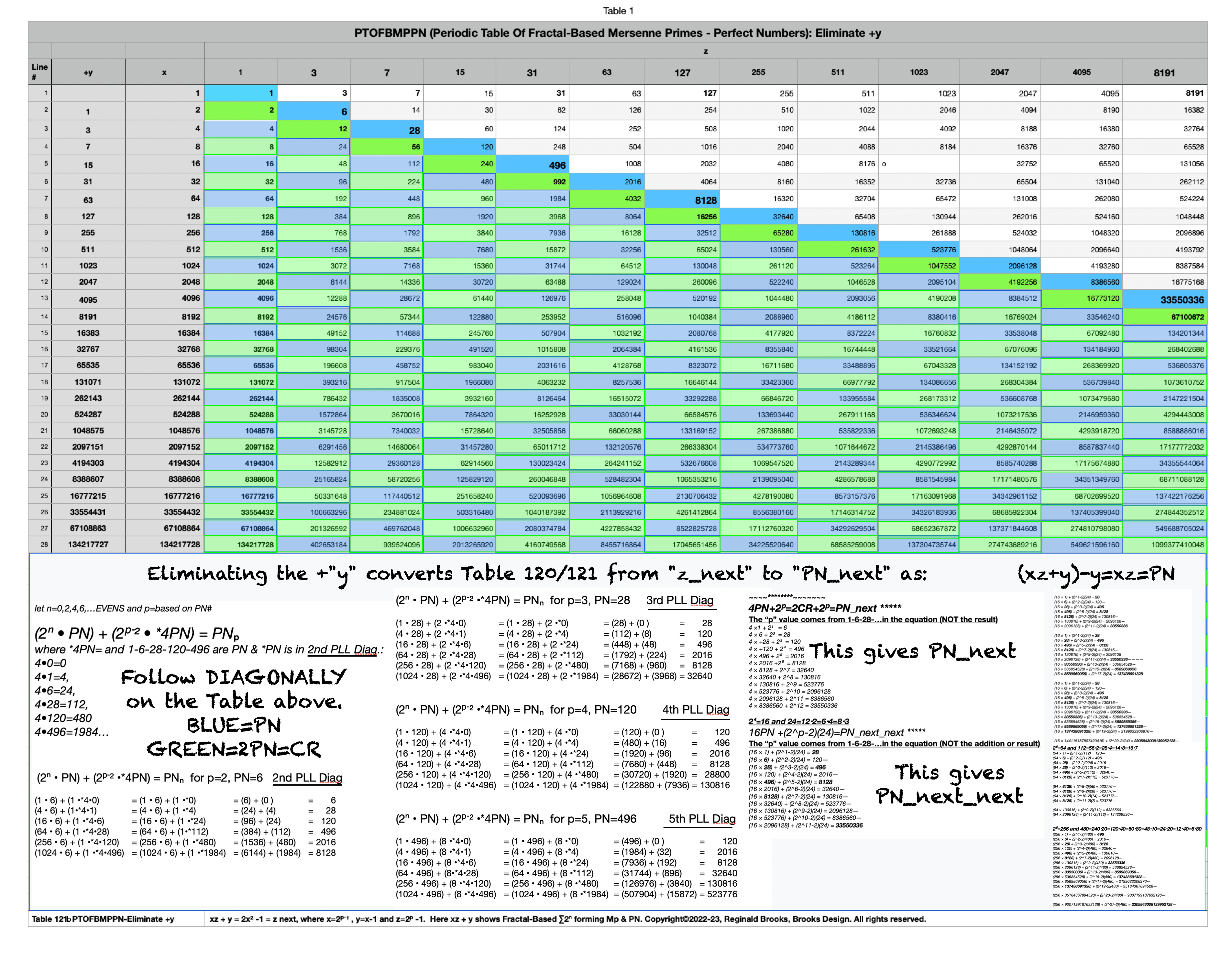
PTOFBMPPN-15.png
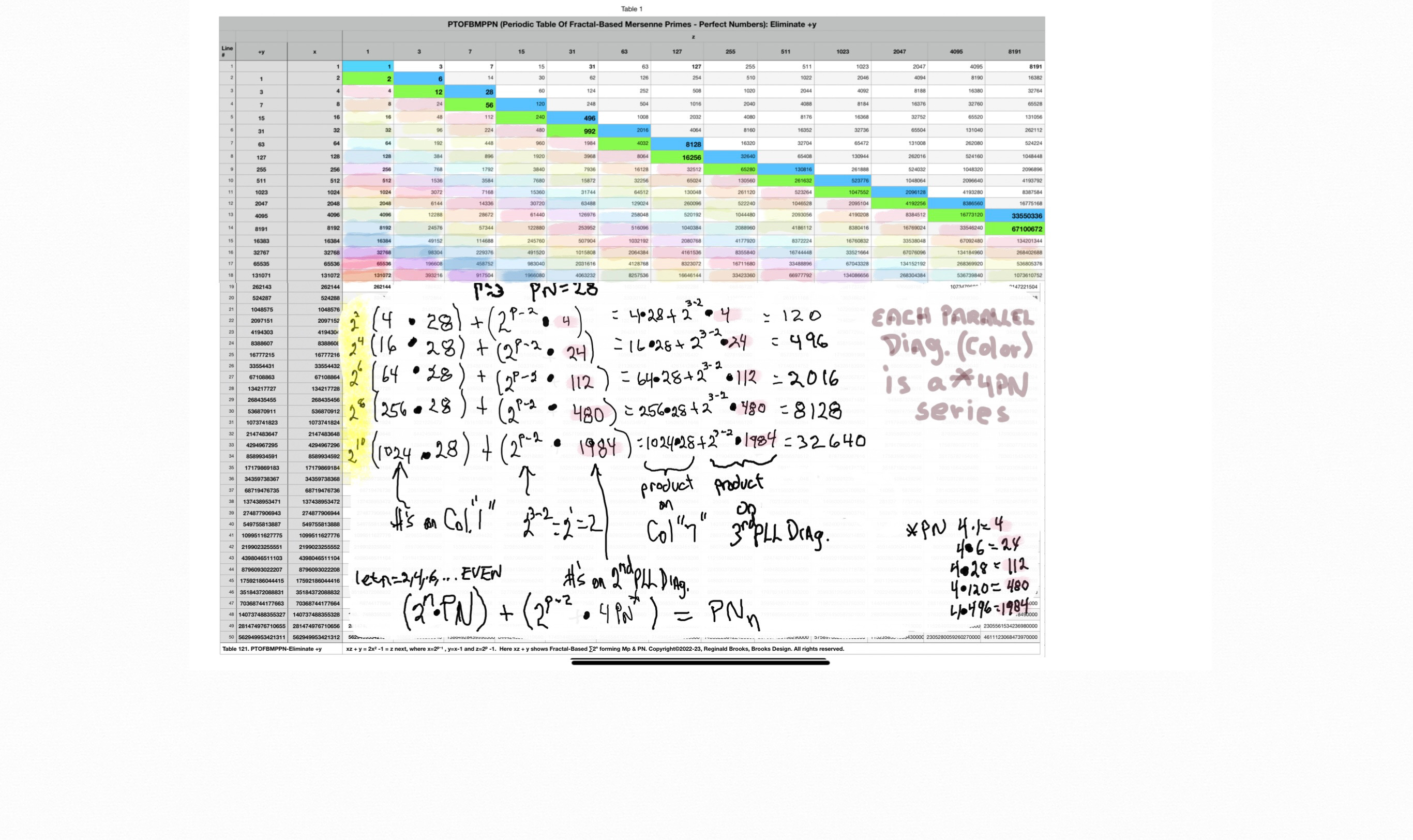
PTOFBMPPN-23.jpg
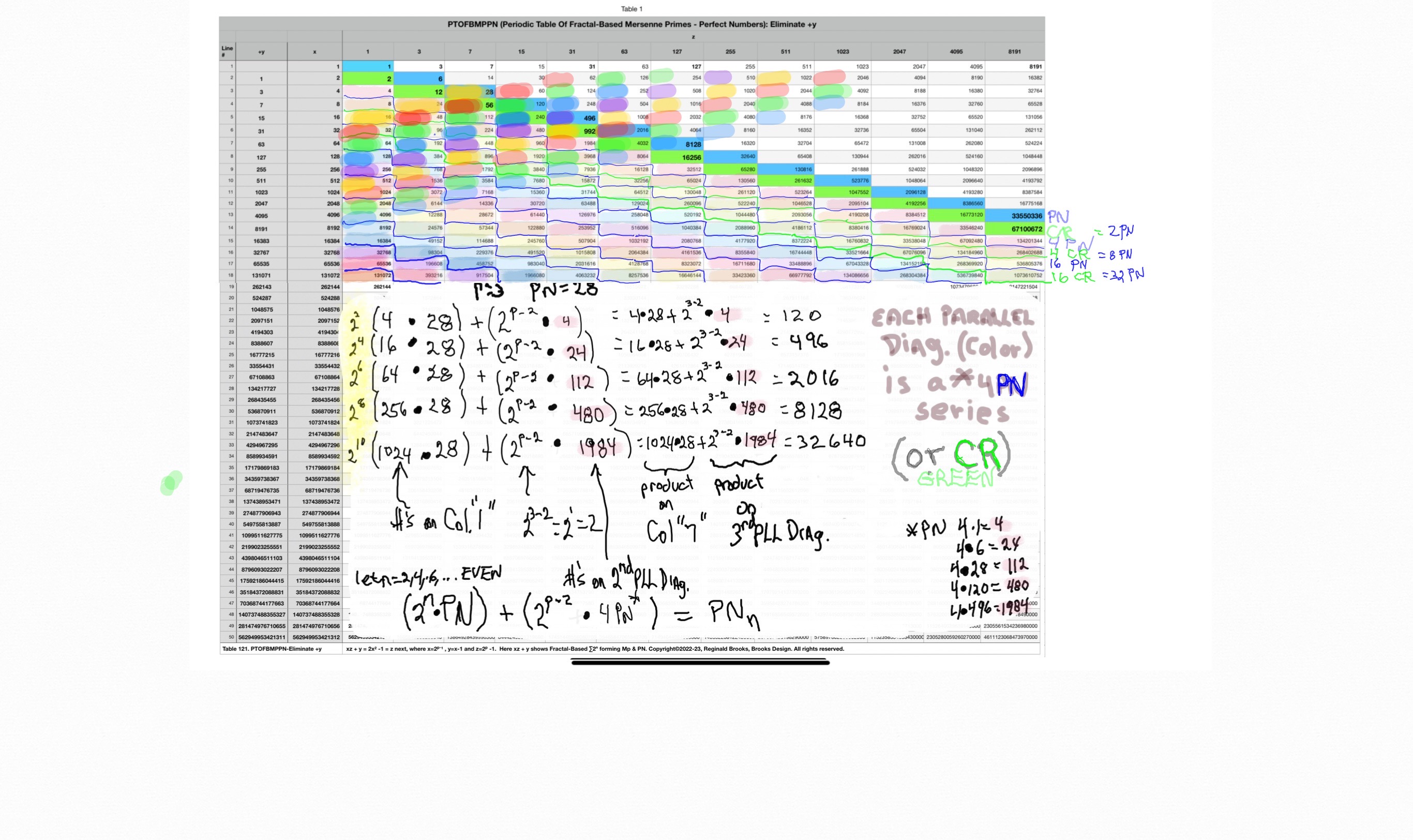
PTOFBMPPN-25.jpg. Each Parallel Diagonal (COLOR) is a 4PN (BLUE) or a CR (GREEN) result.
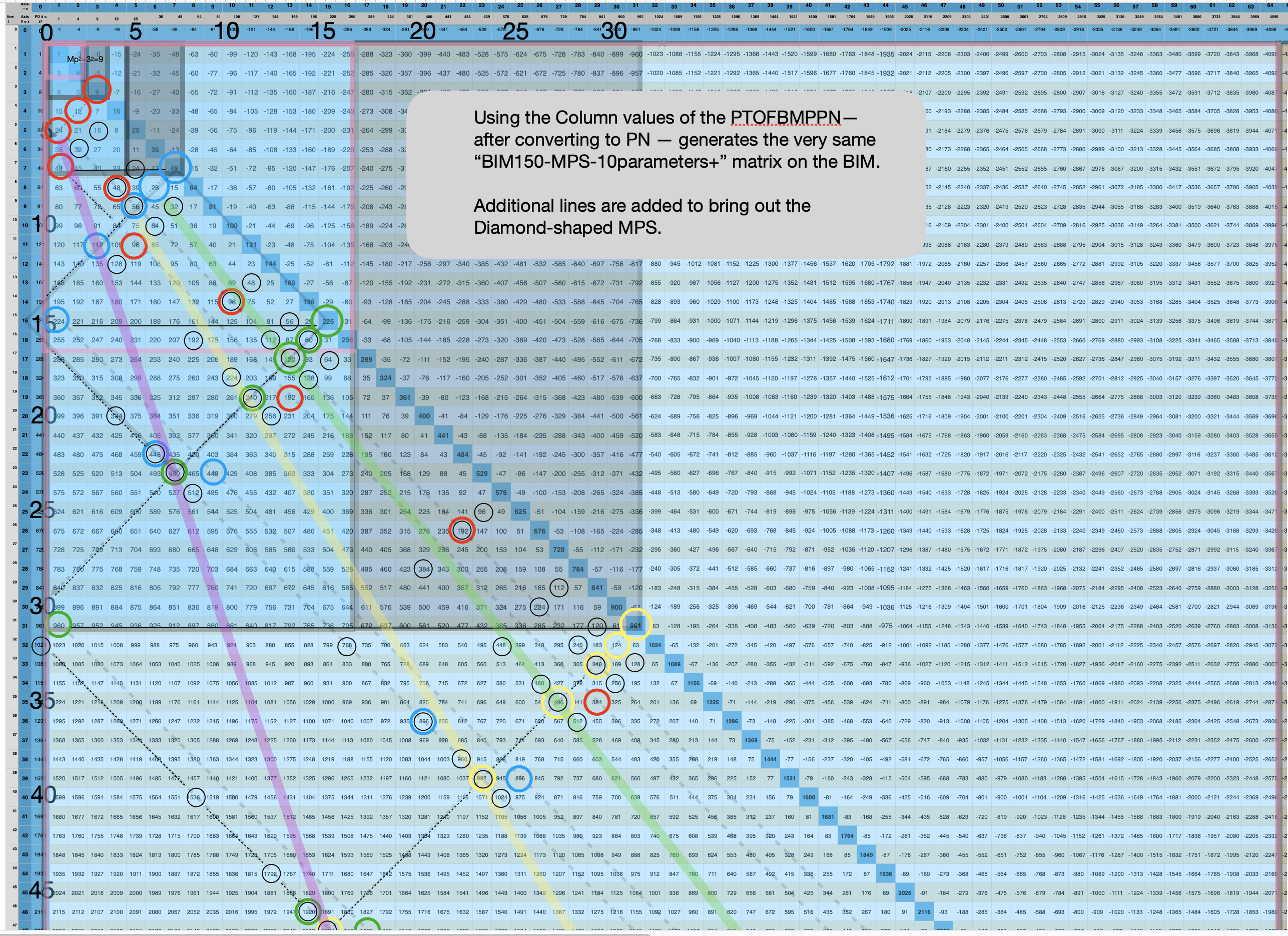
BIM150x150template-3.png. Refresher.
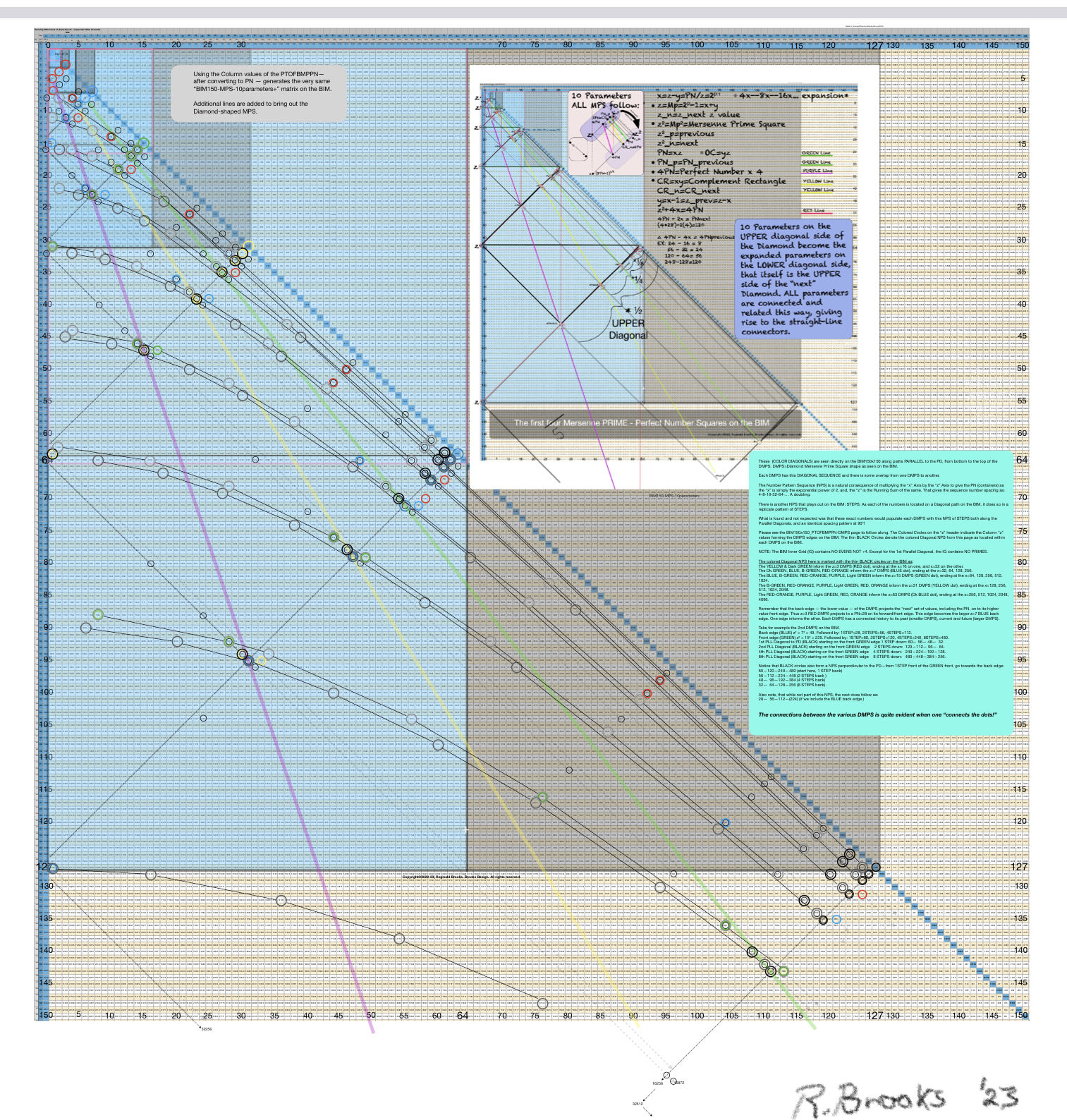
PTOFBMPPN-26.jpg
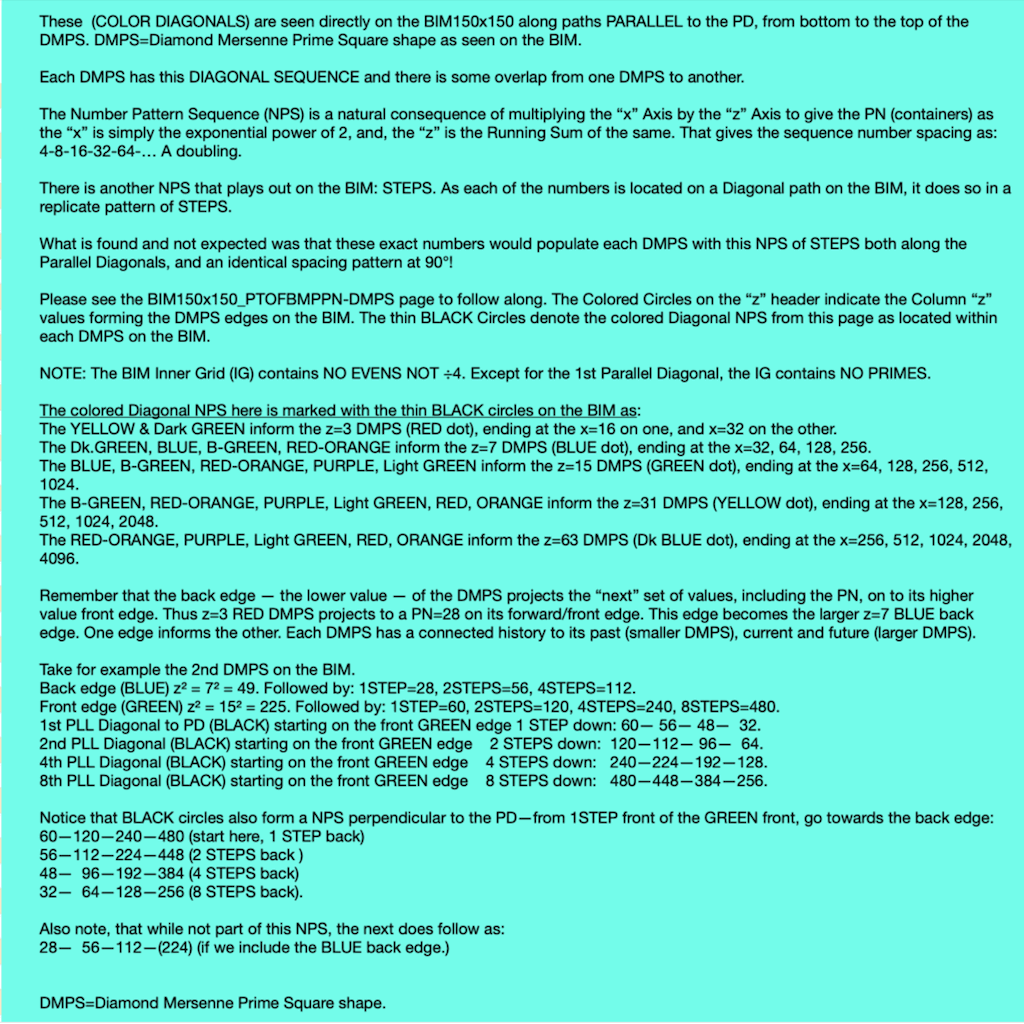
BIM150x150_PTOFBMPPN-DMPS-GREENbox.gif. GREEN Box from PTOFBMPPN-26 above. Also applies below.

BIM150x150_PTOFBMPPN-DMPS-4.pdf. Overview. We will be breaking this image down to some key parts. TIP: Go back and forth. Skim over the next group of images to see both the bigger picture and how some of the details play out. Once you get the pattern on one it will be the same on the others.
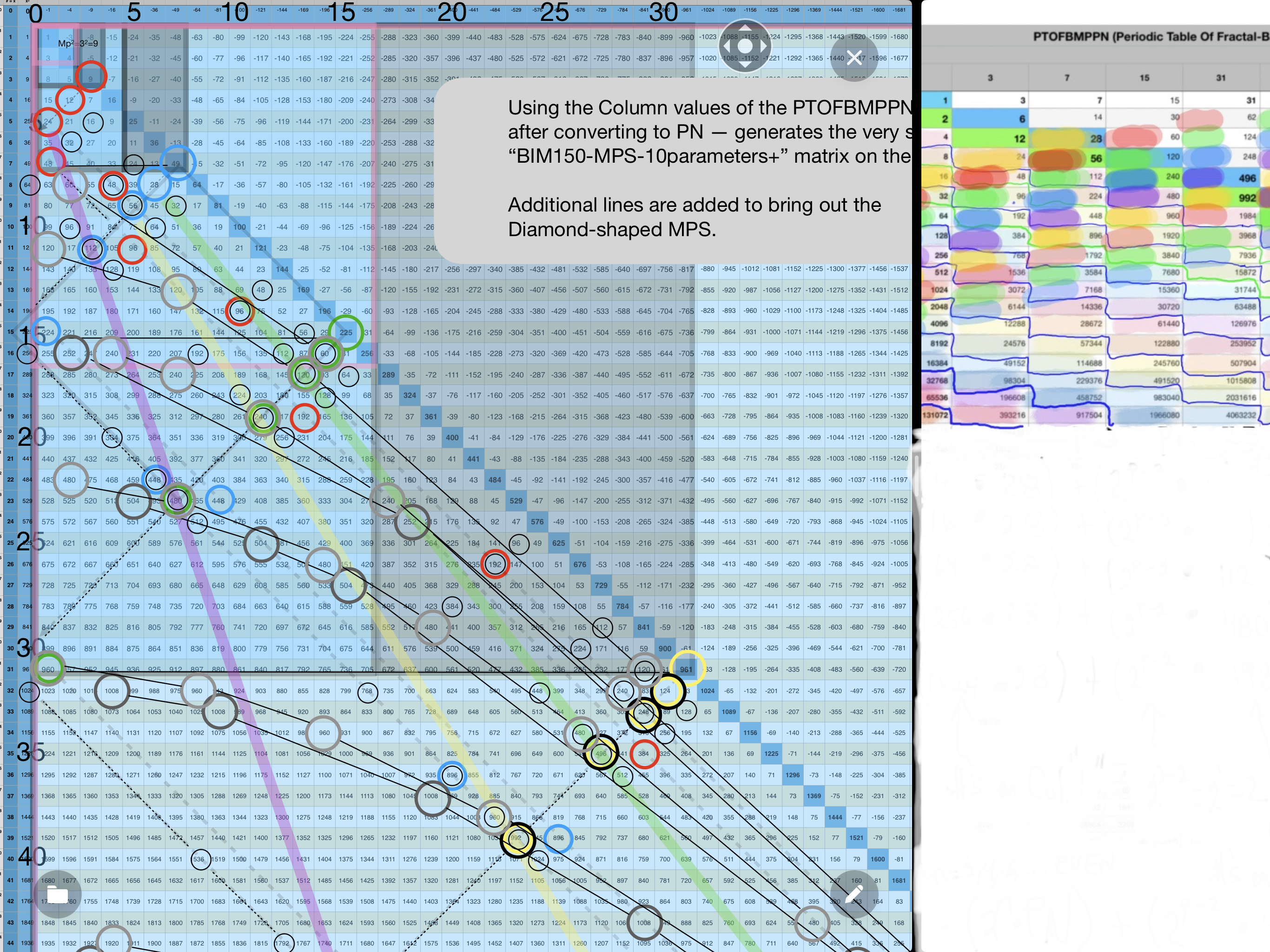
PTOFBMPPN-27.jpg. A blowup of part of the PTOFBMPPN on the right is juxtaposed to the BIM on the left. When referencing the PTOFBMPPN KEY:
• Downward Diagonals (Pastel Colors) go to Background Diagonals (P,Y,G) on the BIM.
• Upward Diagonals (Full Colors) go Parallel to the PD on the BIM.
• Columns (Mixed Colors) go Perpendicular to the PD on the BIM.
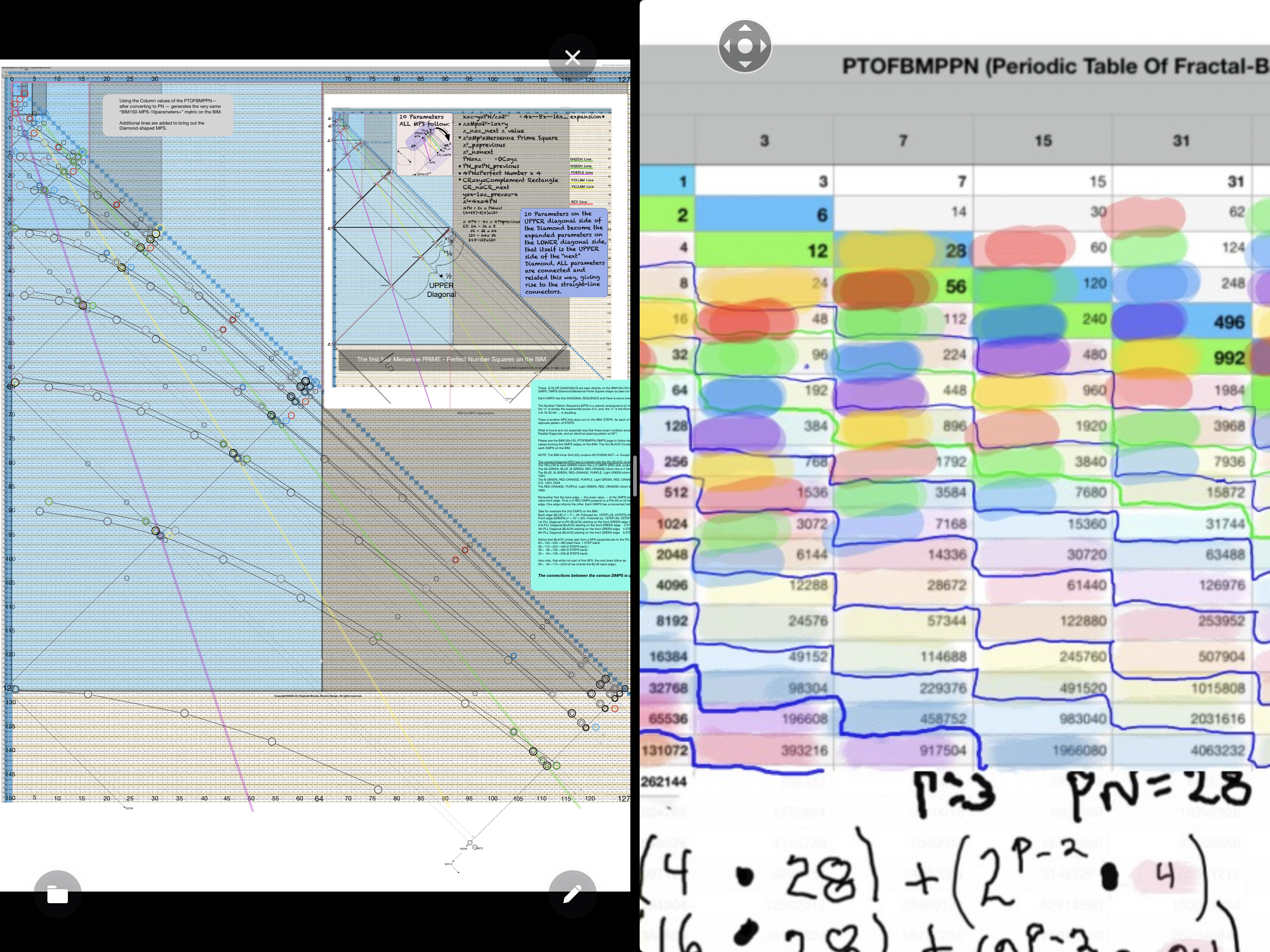
PTOFBMPPN-28.PNG. PTOFBMPPN KEY: Downward Diagonals go to Background Diagonals (P,Y,G). Upward Diagonals go Parallel to the PD. Columns go Perpendicular to the PD.
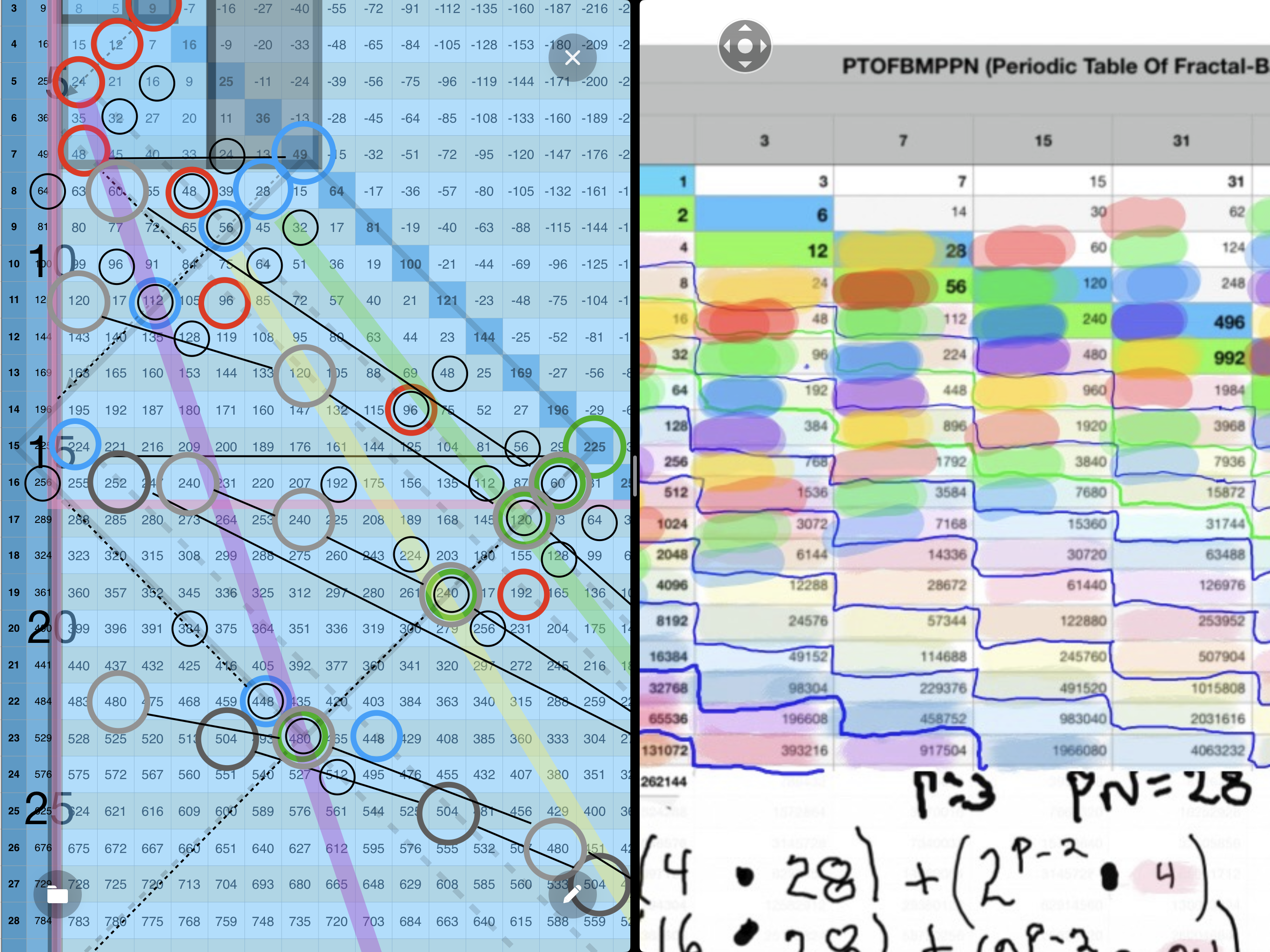
PTOFBMPPN-29.PNG. PTOFBMPPN KEY: Downward Diagonals go to Background Diagonals (P,Y,G). Upward Diagonals go Parallel to the PD. Columns go Perpendicular to the PD.
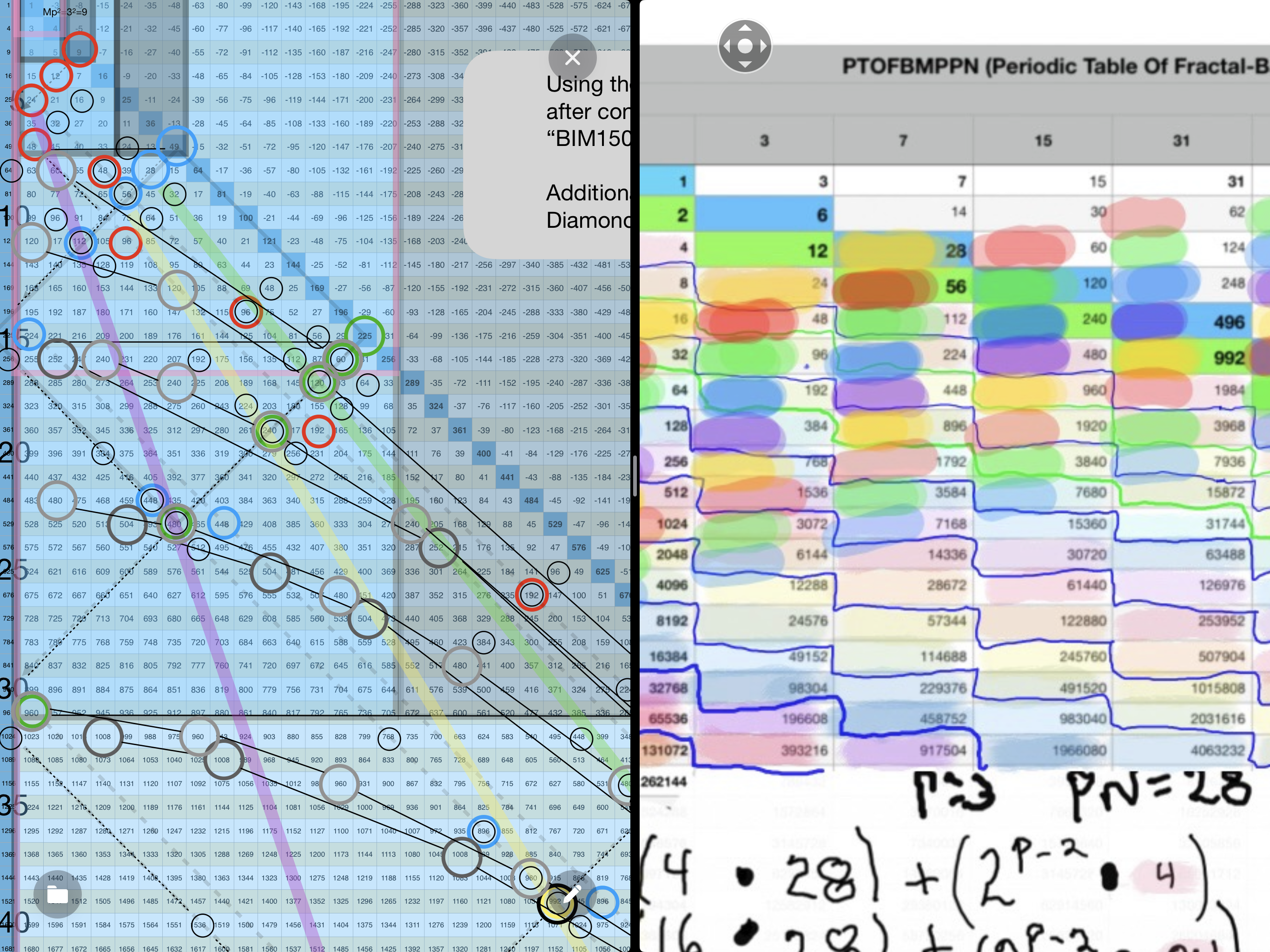
PTOFBMPPN-30.PNG. PTOFBMPPN KEY: Downward Diagonals go to Background Diagonals (P,Y,G). Upward Diagonals go Parallel to the PD. Columns go Perpendicular to the PD.
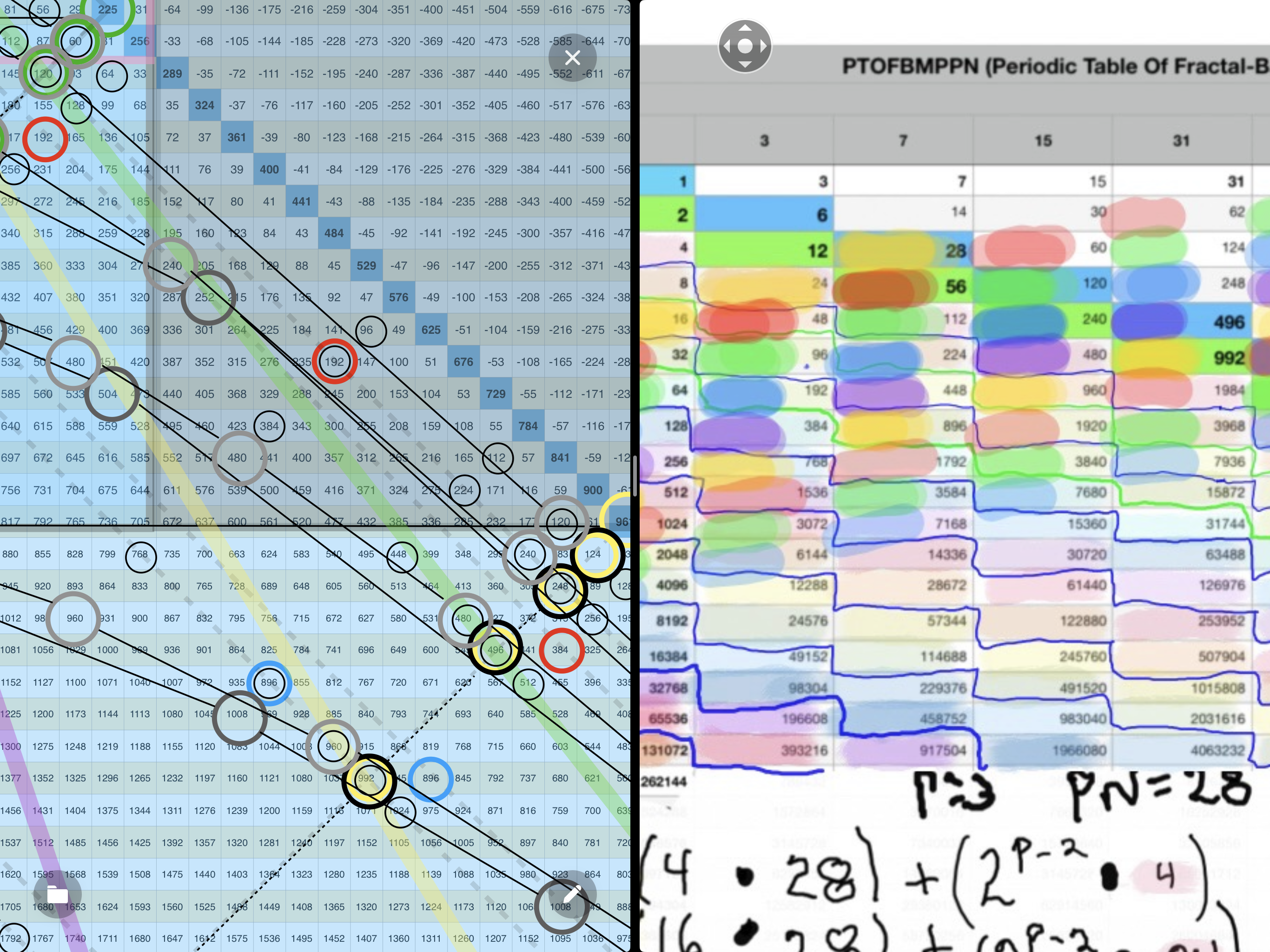
PTOFBMPPN-31.PNG. PTOFBMPPN KEY: Downward Diagonals go to Background Diagonals (P,Y,G). Upward Diagonals go Parallel to the PD. Columns go Perpendicular to the PD.
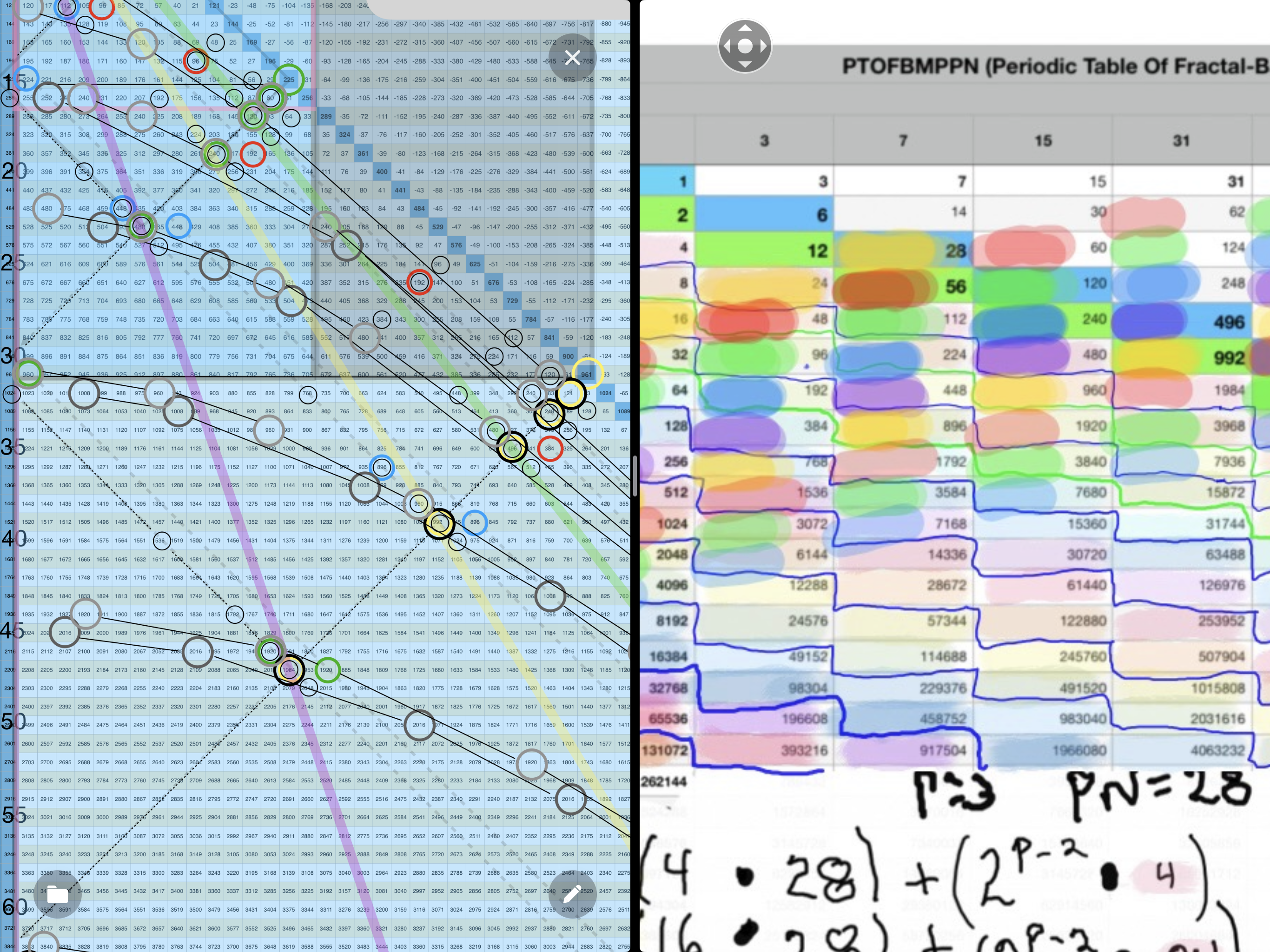
PTOFBMPPN-32.PNG. PTOFBMPPN KEY: Downward Diagonals go to Background Diagonals (P,Y,G). Upward Diagonals go Parallel to the PD. Columns go Perpendicular to the PD.
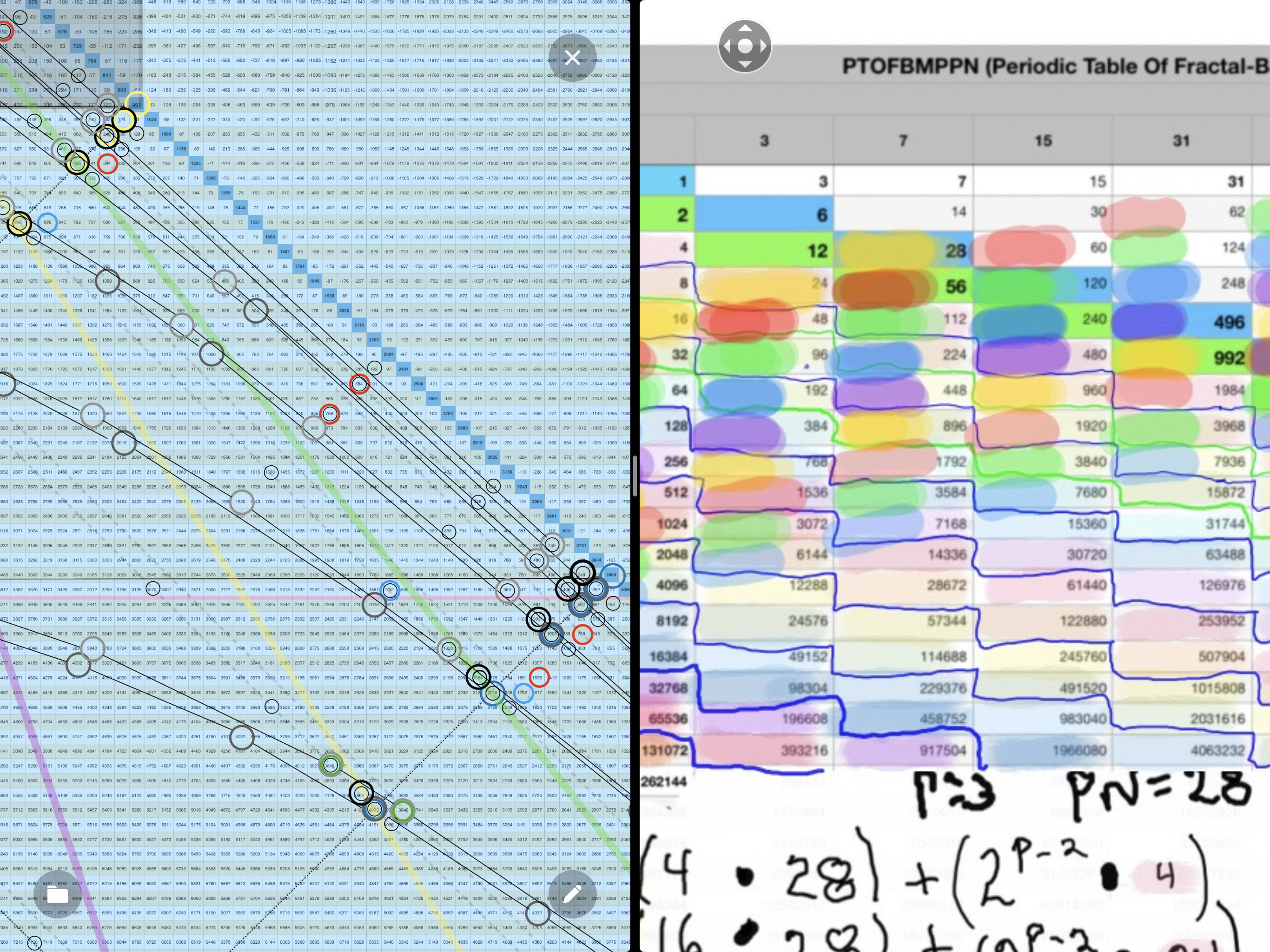
PTOFBMPPN-33.PNG. PTOFBMPPN KEY: Downward Diagonals go to Background Diagonals (P,Y,G). Upward Diagonals go Parallel to the PD. Columns go Perpendicular to the PD.
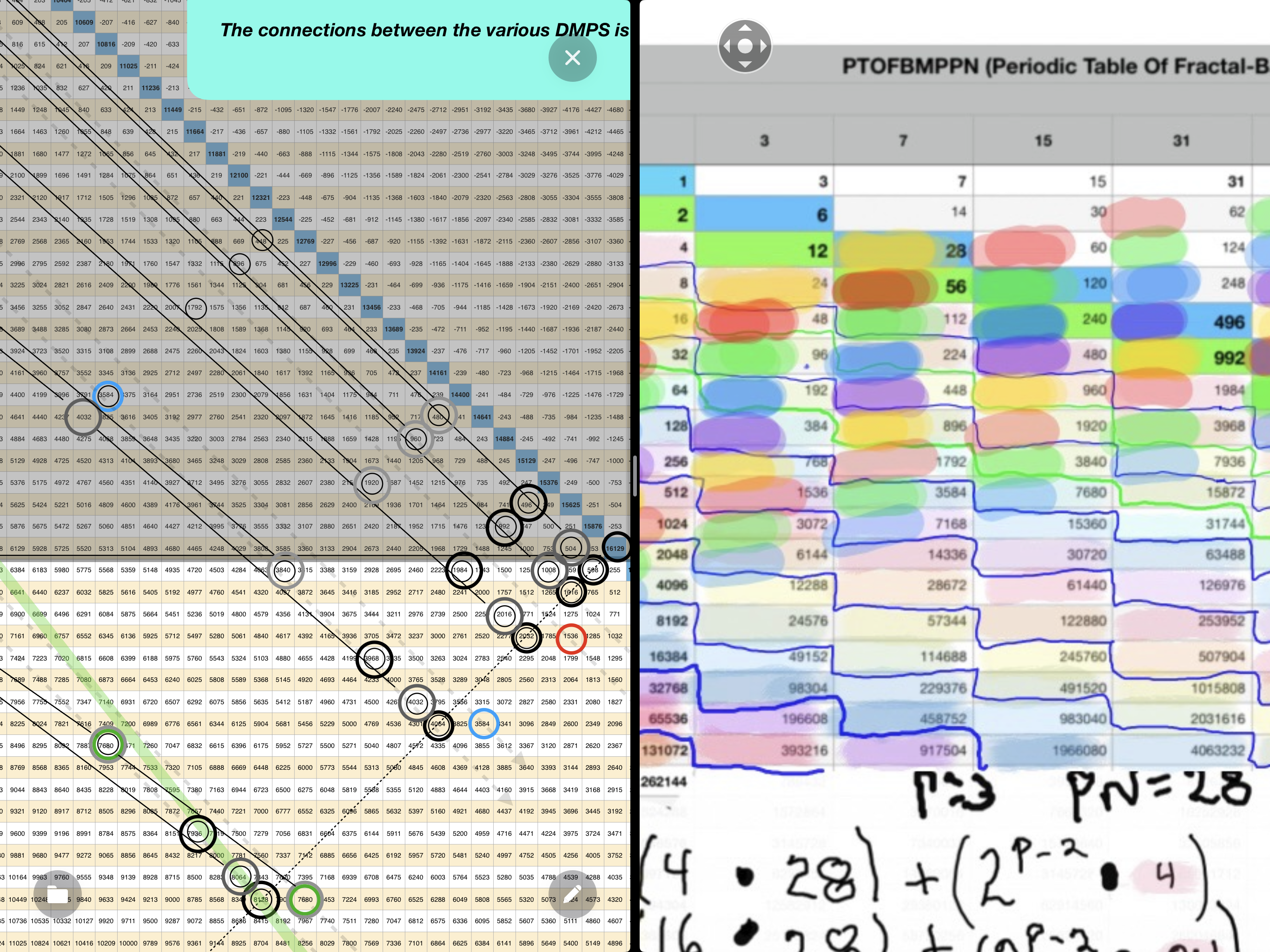
PTOFBMPPN-34.PNG. PTOFBMPPN KEY: Downward Diagonals go to Background Diagonals (P,Y,G). Upward Diagonals go Parallel to the PD. Columns go Perpendicular to the PD.
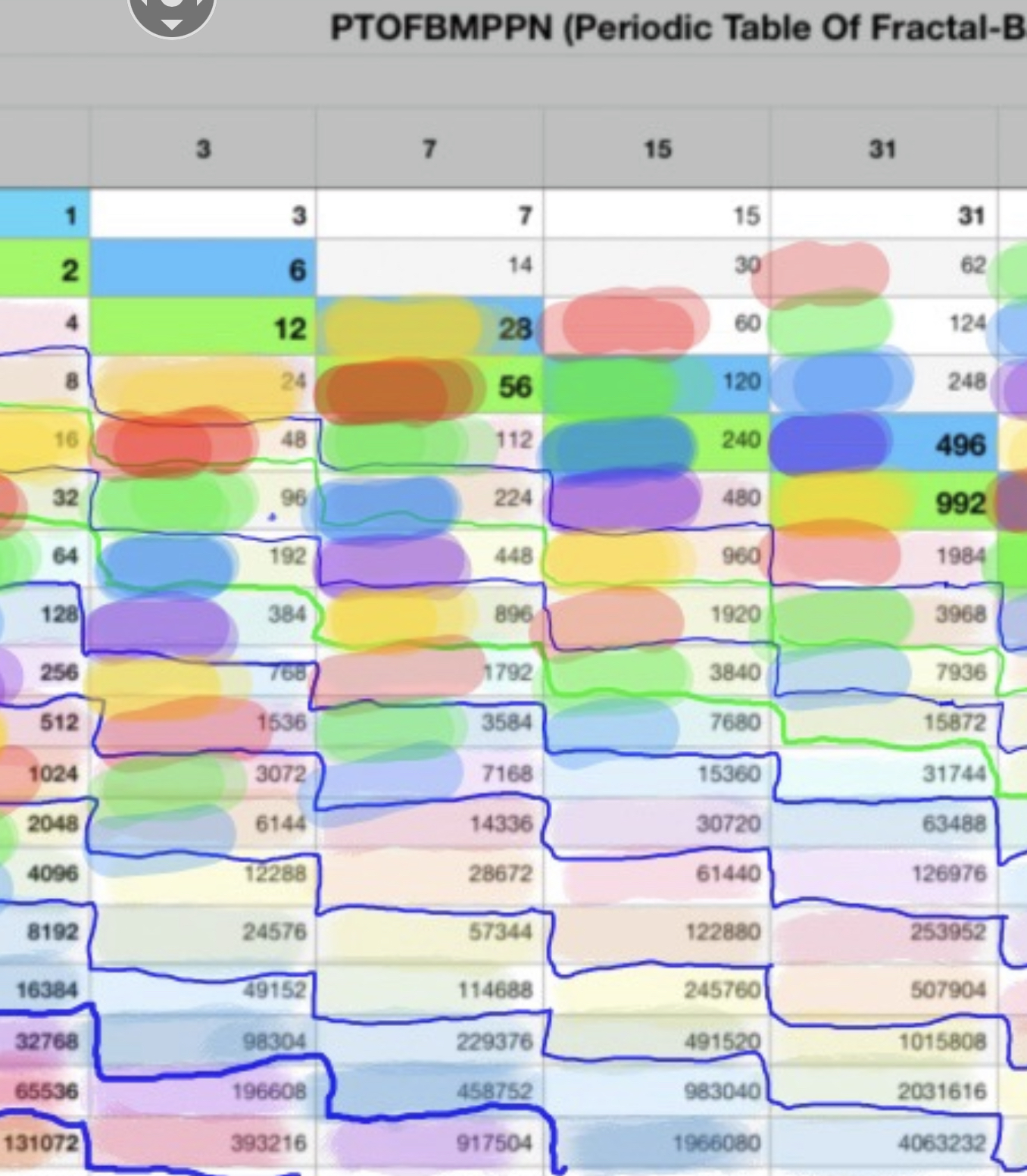
PTOFBMPPN-35.jpg. PTOFBMPPN KEY: Downward Diagonals go to Background Diagonals (P,Y,G). Upward Diagonals go Parallel to the PD. Columns go Perpendicular to the PD.
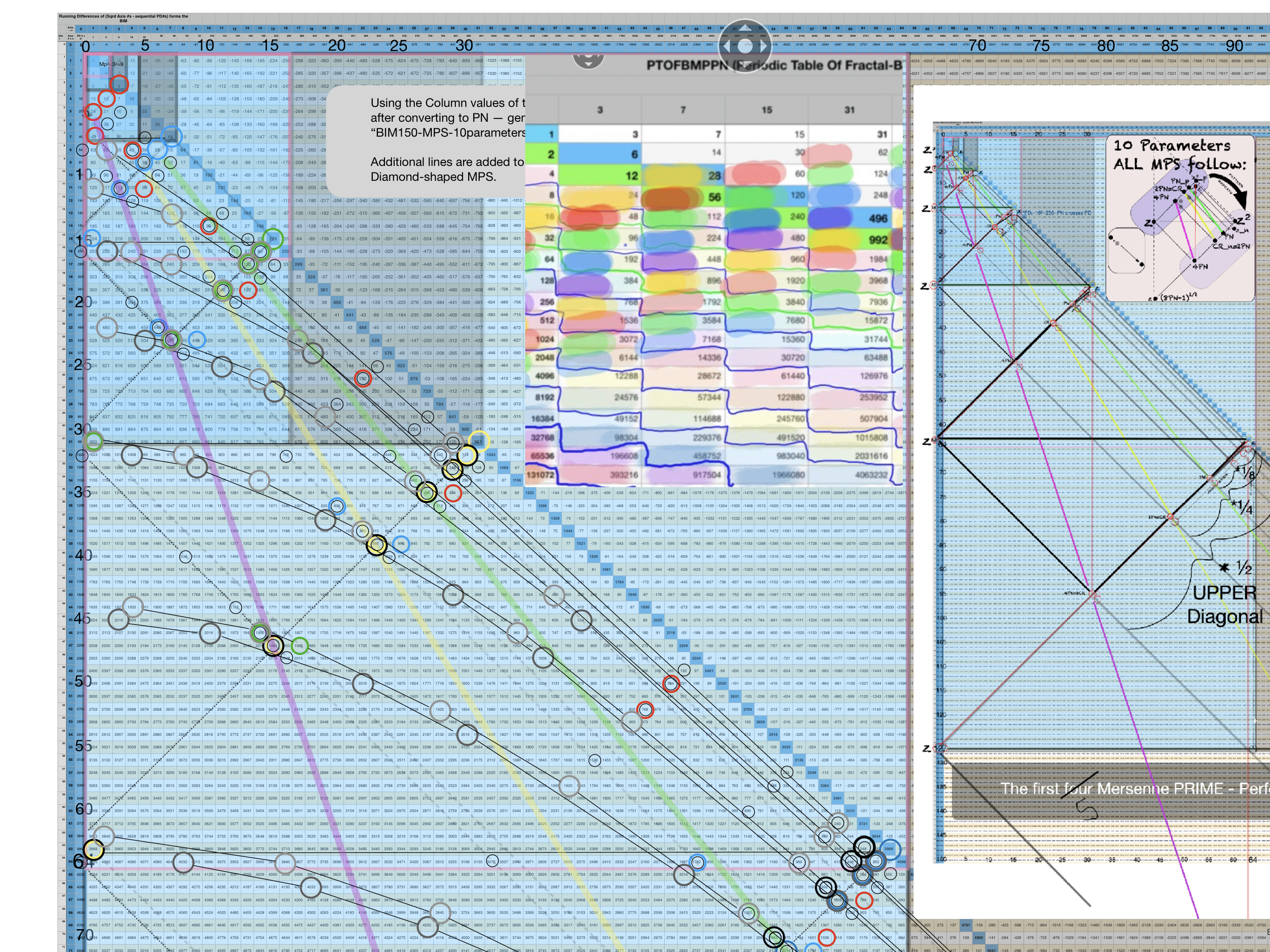
PTOFBMPPN-36.PNG. PTOFBMPPN KEY: Downward Diagonals go to Background Diagonals (P,Y,G). Upward Diagonals go Parallel to the PD. Columns go Perpendicular to the PD.
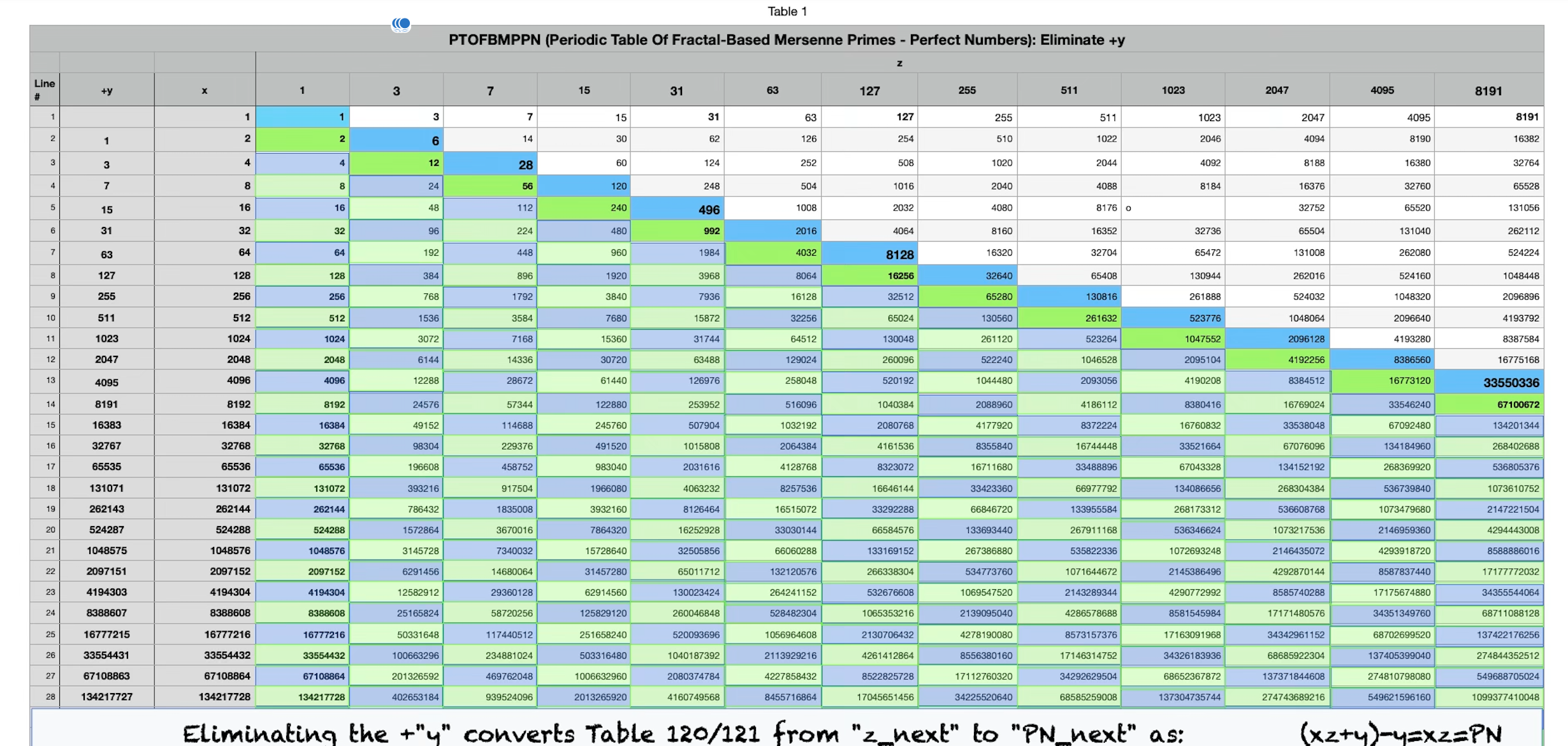
Table120-121_eliminate_y_divide24.png
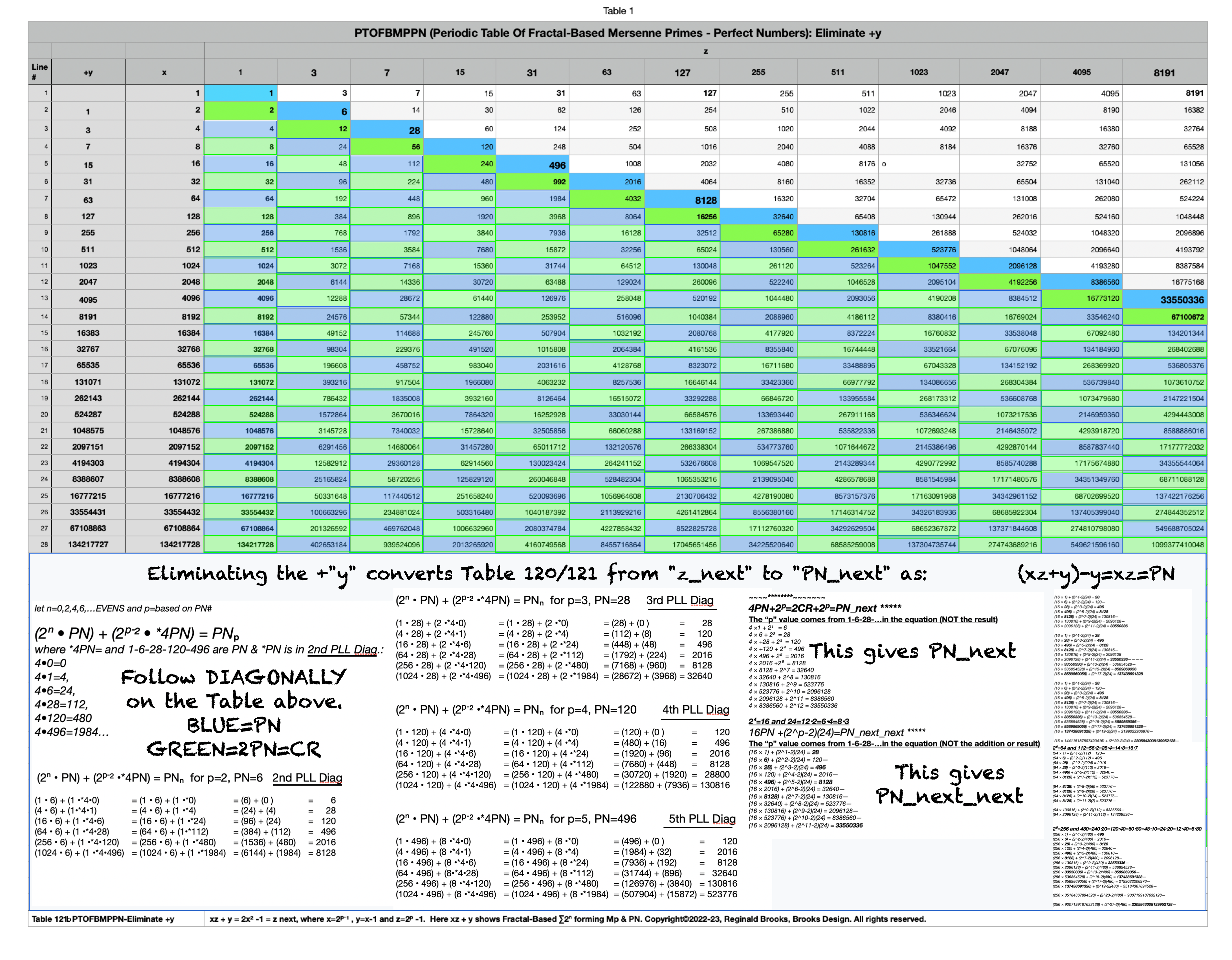
Table120-121b_PTOFBMPPN-11-y.png
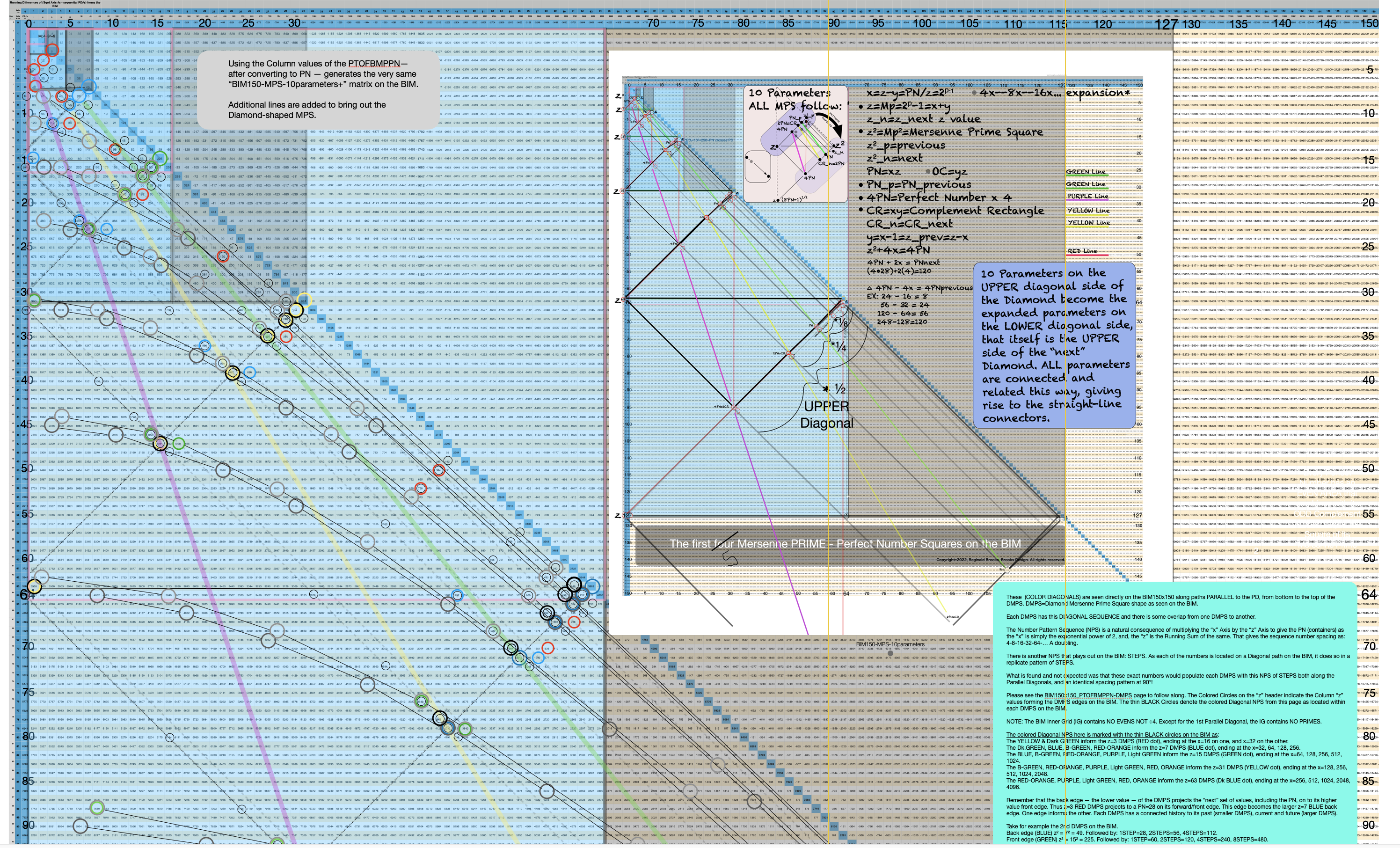
BIM150x150_PTOFBMPPN-DMPS.png
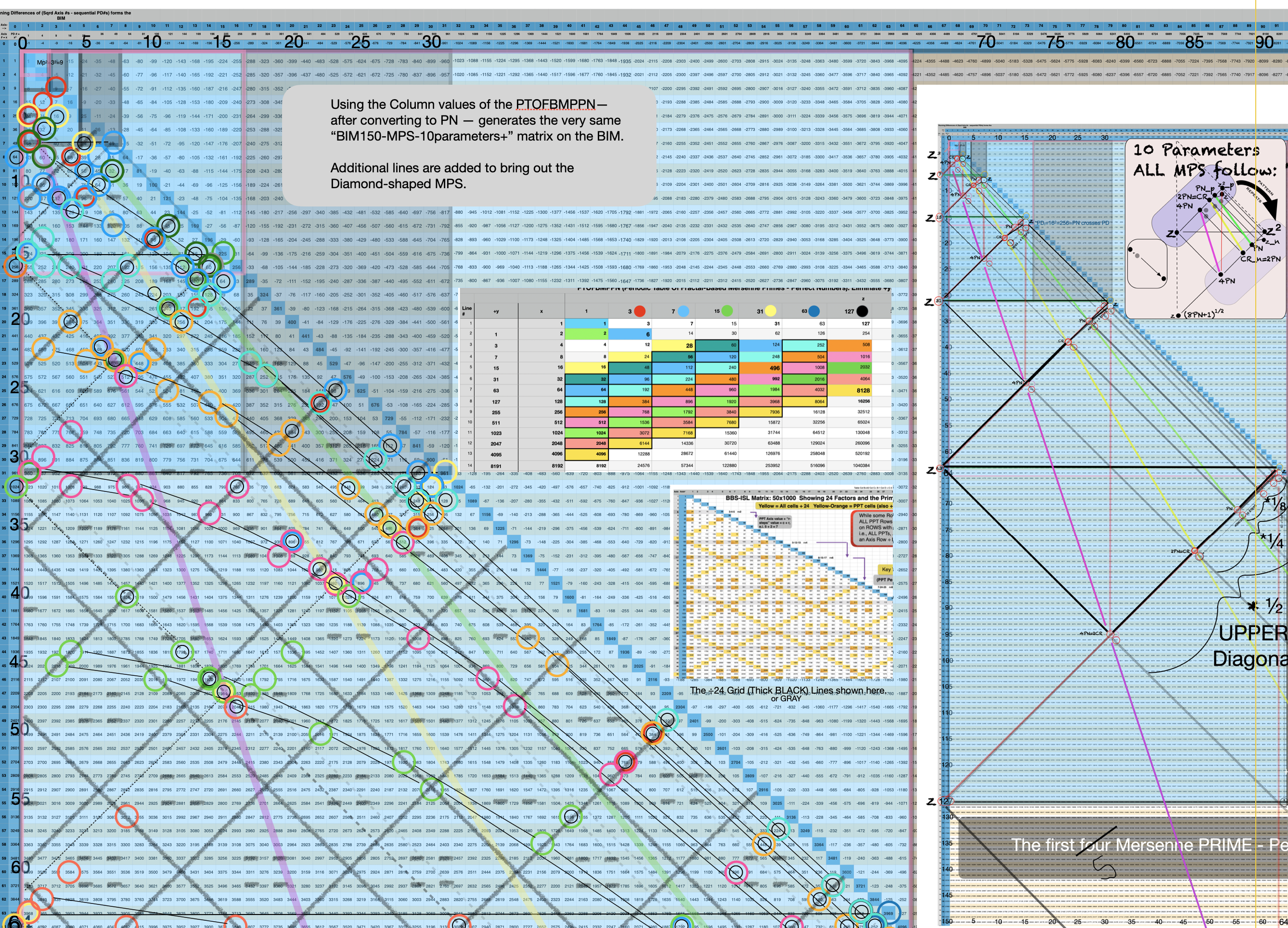
BIM150x150_PTOFBMPPN-DMPS+24light-.png. PTOFBMPPN KEY: Downward Diagonals go to Background Diagonals (P,Y,G). Upward Diagonals go Parallel to the PD. Columns go Perpendicular to the PD.
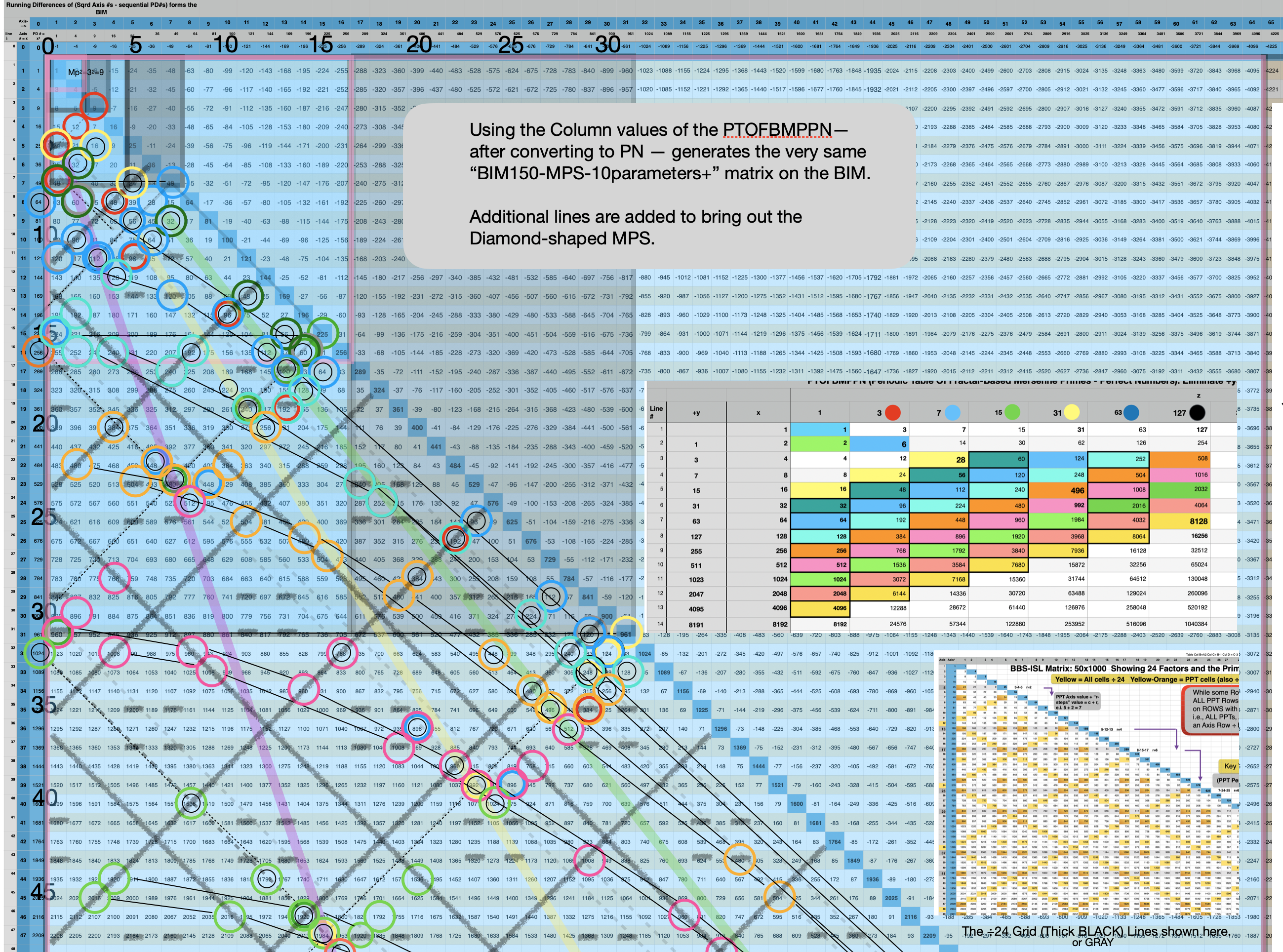
BIM150x150_PTOFBMPPN-DMPS+24light.png. PTOFBMPPN KEY: Downward Diagonals go to Background Diagonals (P,Y,G). Upward Diagonals go Parallel to the PD. Columns go Perpendicular to the PD.
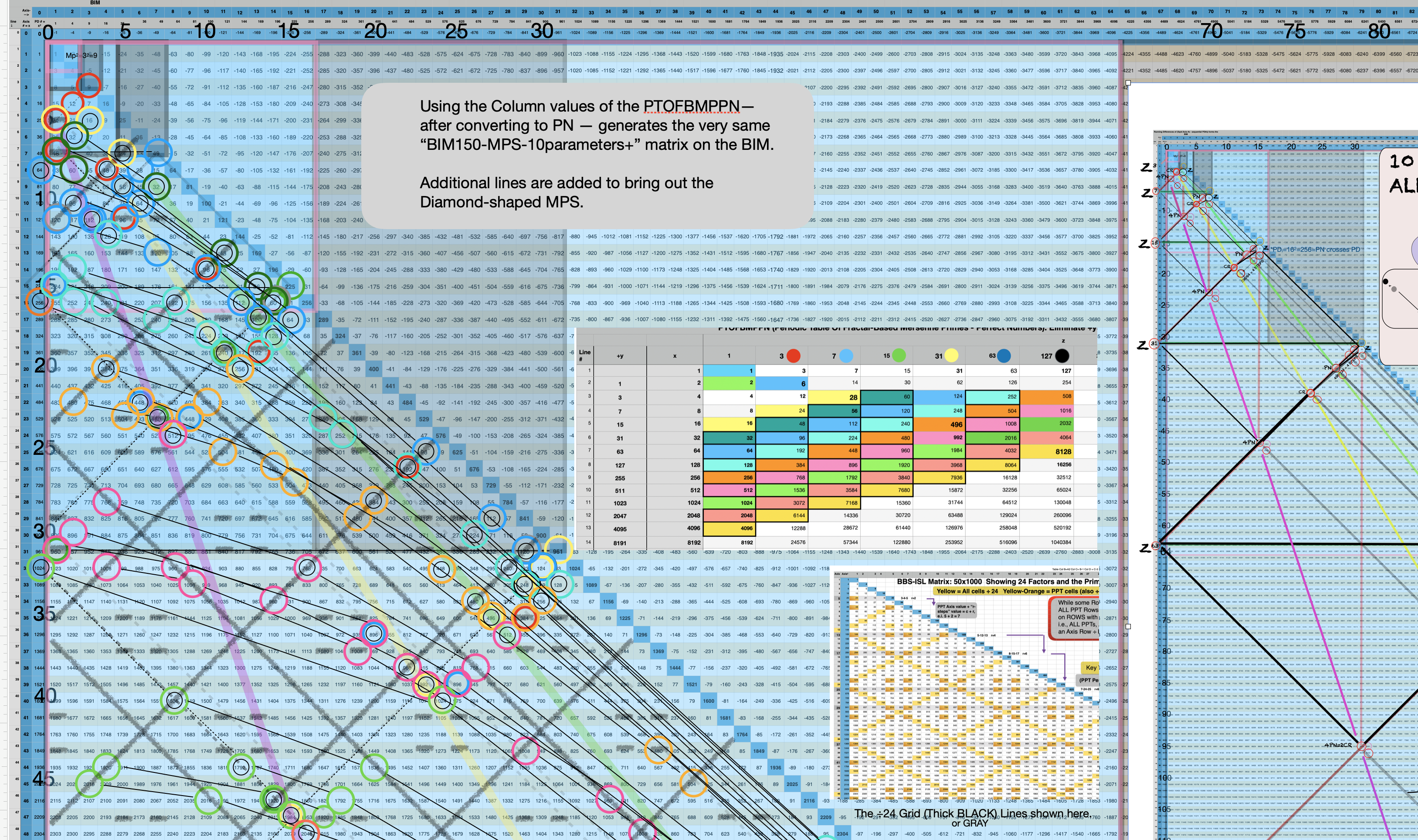
BIM150x150_PTOFBMPPN-DMPS+24light+.png. PTOFBMPPN KEY: Downward Diagonals go to Background Diagonals (P,Y,G). Upward Diagonals go Parallel to the PD. Columns go Perpendicular to the PD.
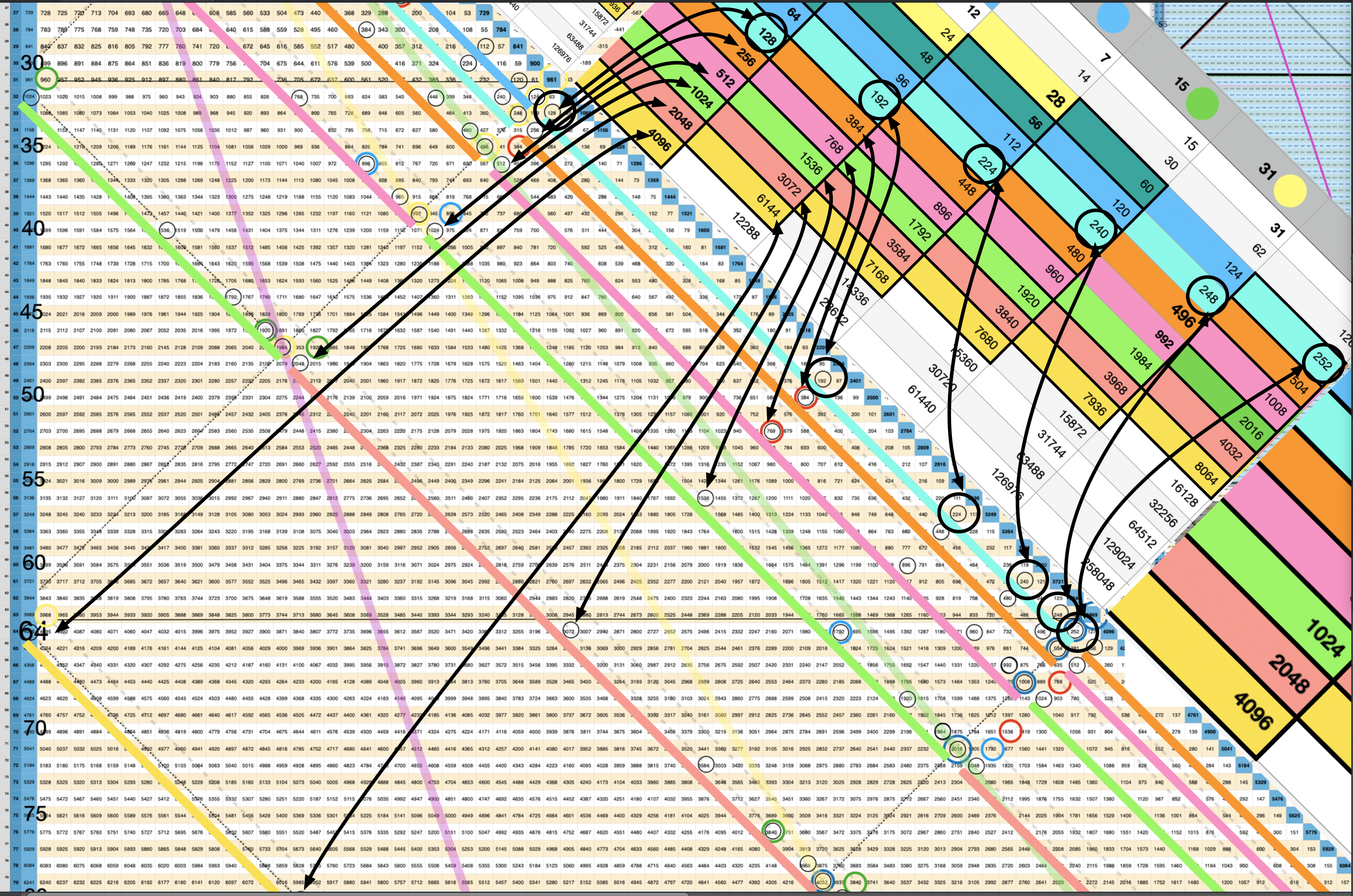
BIM150x150_PTOFBMPPN-DMPSlayer2-+.png. PTOFBMPPN KEY: Downward Diagonals go to Background Diagonals (P,Y,G). Upward Diagonals go Parallel to the PD. Columns go Perpendicular to the PD.
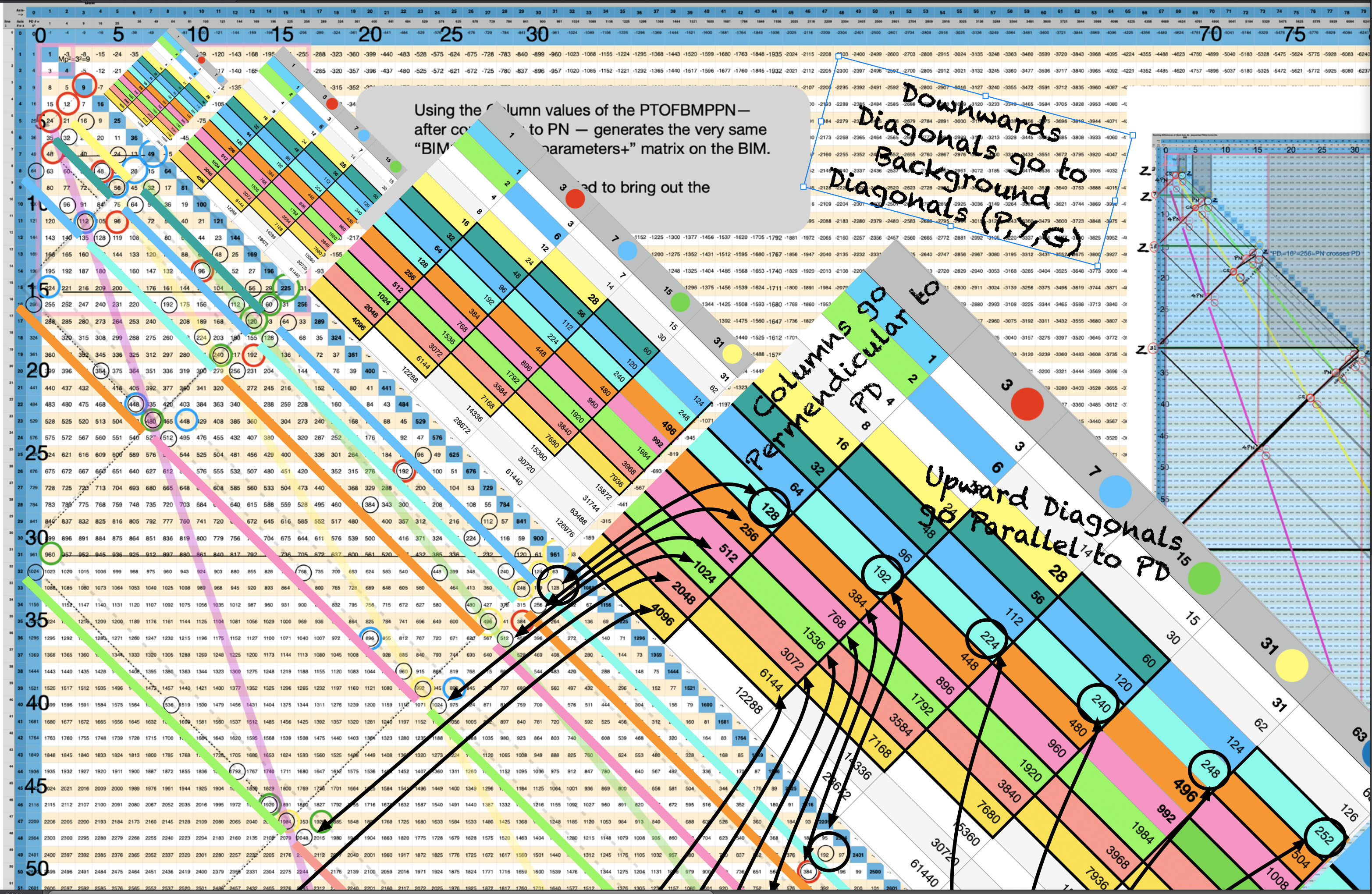
BIM150x150_PTOFBMPPN-DMPSlayer2--+.png. PTOFBMPPN KEY: Downward Diagonals go to Background Diagonals (P,Y,G). Upward Diagonals go Parallel to the PD. Columns go Perpendicular to the PD.

BIM150x150_PTOFBMPPN-DMPSlayer5--+.pdf. PTOFBMPPN KEY: Downward Diagonals go to Background Diagonals (P,Y,G). Upward Diagonals go Parallel to the PD. Columns go Perpendicular to the PD.

BIM150x150_PTOFBMPPN-DMPSlayer2+.pdf. PTOFBMPPN KEY: Downward Diagonals go to Background Diagonals (P,Y,G). Upward Diagonals go Parallel to the PD. Columns go Perpendicular to the PD.

BIM150x150_PTOFBMPPN-DMPSlayer3+.pdf. PTOFBMPPN KEY: Downward Diagonals go to Background Diagonals (P,Y,G). Upward Diagonals go Parallel to the PD. Columns go Perpendicular to the PD.

BIM150x150_PTOFBMPPN-DMPSlayer4+.pdf. PTOFBMPPN KEY: Downward Diagonals go to Background Diagonals (P,Y,G). Upward Diagonals go Parallel to the PD. Columns go Perpendicular to the PD.

BIM150x150_PTOFBMPPN-DMPSlayer5+.pdf. PTOFBMPPN KEY: Downward Diagonals go to Background Diagonals (P,Y,G). Upward Diagonals go Parallel to the PD. Columns go Perpendicular to the PD.

BIM150-MPS-BF1+.pdf. Back to the simplicity of "The Exponential Power of 2 as it interferes with the MPS" on the BIM. The Running Sums (∑) of the doublings of quantity one (Butterfly Fractal 1) - 1--3-7-15-31-63-127-255-511-1023-2047-4095-8191... gives us the MPS, Mp, PN, OC, CR...

Table128_PTOFBMPPNsubtract.pdf

Table129_PTOFBMPPNsubtractGroups.pdf
The PTOFBMPPN started with:
The Periodic Table Of Fractal-Based Mersenne Prime - Perfect Numbers is a keystone table in the sense that it can unlock so many of the interconnections between the basic Butterfly Fractal and the 10 component parameters of every MPS -- both the active, true and the active, but "container-only" resonant forms.
Perhaps the single most constant challenge throughout the entire BIMMPS discovery process has been keeping track of those 10 parameters. Why? Because of their immense overlap. y is simply x-1, y in "containers" becomes z in active, true MPS. x becomes x2 and when doubled +1 becomes z, x+y=z and xy=CR, and x and z are just manifestations of p (less one). And it goes on and on.
But there is a reason. It results from them being the products of the interference pattern of Butterfly Fractal that informs them all!
To start, we will show where this PTOFBMMPNs is going -- right straight to BIM!
Don't worry, we will then be going on a little journey to see how we got there.
A picture is worth a thousand words:
There is a place for the tables and then there is a place on the BIM that shows just what is going on in the tables. It does get very busy. The point is that the BIM actually contains it all. It contains each and every "containter" and the rare Mp-PN pairing that fills some (51+) of those "containers."
In the previous work (Book IV) we saw the individual "containers" and Mp-PN profiled as Diamond-shaped MPS with their 10 parameters on the BIM. Here we have seen how the PTOFBMPPN fills in and relates to those individual profiles.
The advantage of the "table" form of presentation is that a large number of profiles can be brought together such that there Number Pattern Sequences (NPS) can be more easily discerned.
Looking at the details within a closeup indivdual profile on the BIM presents a breakdown of the individual elements of any said player in that NPS. And that is the point: while the individual numbers within a profile will change, the overall NPS is constant. This, of course, rewards careful study of a few closeup profiles to see and understand the pattern. Thereafter, one can locate any other Mp-PN pairing and know exactly where and how to characterize its NPS profile. It will be predictably the same!
NEXT: BOOK VI: Summary, Conclusion, References and Appendix I
LINKS:
Mersenne Prime Squares (Part I) the Introductory white paper.
Mersenne Prime Squares (Part II) 3 Simple Intros.
Mersenne Prime Squares (Part III) the Advanced white paper.
The MPS Project The Mersenne Prime Squares Project.
LINKS:MathspeedST: TPISC Media Center
MathspeedST: eBook (free)
Apple Books
Artist Link in iTunes Apple Books Store:
Reginald Brooks
 KEYWORDS TAGS:
BMP, BIM-MersenneSquare-PerfectNumber, Mersenne Primes, Mersenne Prime Square, Perfect Number, Perfect Square, MPS, Mp, PTOP, Periodic Table Of PRIMES, PRIMES vs NO-PRIMES, algebraic geometry, BIM, TPISC, The Pythagorean - Inverse Square Connections, Pythagorean Triangles, DNA, Zika virus, pentagon, decagon, double pentagon, composite axial DNA double-helix, Pythagorean Triples, primitive Pythagorean Triples, non-primitive Pythagorean Triples, Pythagorean Theorem, Pythagorus Theorem, The Dickson Method, BBS-ISL Matrix, Expanded Dickson Method, r-sets, s-set, t-sets, Pair-sets, geometric proofs, MathspeedST, leapfrogging LightspeedST FASTER than the speed of light, Brooks (Base) Square- Inverse Square Law (ISL), BBS-ISL Matrix grid, The Architecture Of SpaceTime (TAOST), The Conspicuous Absence Of Primes (TCAOP), A Fresh Piece Of Pi(e), AFPOP, Numbers of Inevitability, LightspeedST, Teachers, Educators and Students (TES), number theory, ubiquitous information, FASTER than the speed of light, primes, prime numbers, fractals, mathematics, Universe, cosmos, patterns in number, DSEQEC, Double-Slit Experiment-Quantum Entanglement Conjecture, CaCost, Creation and Conservation of SpaceTime.
KEYWORDS TAGS:
BMP, BIM-MersenneSquare-PerfectNumber, Mersenne Primes, Mersenne Prime Square, Perfect Number, Perfect Square, MPS, Mp, PTOP, Periodic Table Of PRIMES, PRIMES vs NO-PRIMES, algebraic geometry, BIM, TPISC, The Pythagorean - Inverse Square Connections, Pythagorean Triangles, DNA, Zika virus, pentagon, decagon, double pentagon, composite axial DNA double-helix, Pythagorean Triples, primitive Pythagorean Triples, non-primitive Pythagorean Triples, Pythagorean Theorem, Pythagorus Theorem, The Dickson Method, BBS-ISL Matrix, Expanded Dickson Method, r-sets, s-set, t-sets, Pair-sets, geometric proofs, MathspeedST, leapfrogging LightspeedST FASTER than the speed of light, Brooks (Base) Square- Inverse Square Law (ISL), BBS-ISL Matrix grid, The Architecture Of SpaceTime (TAOST), The Conspicuous Absence Of Primes (TCAOP), A Fresh Piece Of Pi(e), AFPOP, Numbers of Inevitability, LightspeedST, Teachers, Educators and Students (TES), number theory, ubiquitous information, FASTER than the speed of light, primes, prime numbers, fractals, mathematics, Universe, cosmos, patterns in number, DSEQEC, Double-Slit Experiment-Quantum Entanglement Conjecture, CaCost, Creation and Conservation of SpaceTime.
| PIN: Pattern in Number...from primes to DNA. | PIN: Butterfly Primes...let the beauty seep in. | PIN: Butterfly Prime Directive...metamorphosis. | PIN: Butterfly Prime Determinant Number Array (DNA) ~conspicuous abstinence~. | GoDNA: the Geometry of DNA (axial view) revealed. | SCoDNA: the Structure and Chemistry of DNA (axial view). | The LUFE Matrix | The LUFE Matrix Supplement | The LUFE Matrix: Infinite Dimensions | The LUFE Matrix: E=mc2 | Dark Matter=Dark Energy | The History of the Universe in Scalar Graphics | The History of the Universe_update: The Big Void | Quantum Gravity ...by the book | The Conservation of SpaceTime | LUFE: The Layman's Unified Field Expose` | GoMAS: The Geometry of Music, Art and Structure ...linking science, art and esthetics. Part I | Brooks (Base) Square (BBS): The Architecture of Space-Time (TAOST) and The Conspicuous Absence of Primes (TCAOP) - a brief introduction to the series | more White Papers...
|
|
|
| net.art index | netart01: RealSurReal...aClone, 2001 | netart02: Hey!Ufunk'n with my DNA? | netart03: 9-11_remembered | netart04: Naughty Physics (a.k.a. The LUFE Matrix) | netart05: Your sFace or Mine? | netart06: Butterfly Primes | netart07: Music-Color-ISL | netart08: BBS-ISL matrix | netart09: BBS-interactive (I) | netart10: Sunspots and Solar Flares | netart11: Music-Color-ISL (II-III) | Art Theory 101: PIN, DNA, LUFE Matrix, GoMAS, BBS index | home
| Art Theory 101 / White Papers Index
|
Copyright 2021-23, Reginald Brooks, Brooks Design. All rights reserved.
|
|
iTunes, iTunes Store, Apple Books, iBooks, iBooks Store, iBooks Author, Mac OS are registered® trademarks of Apple Inc. and their use on this webpage does not reflect endorsement by Apple Inc.
|
TOP













































































